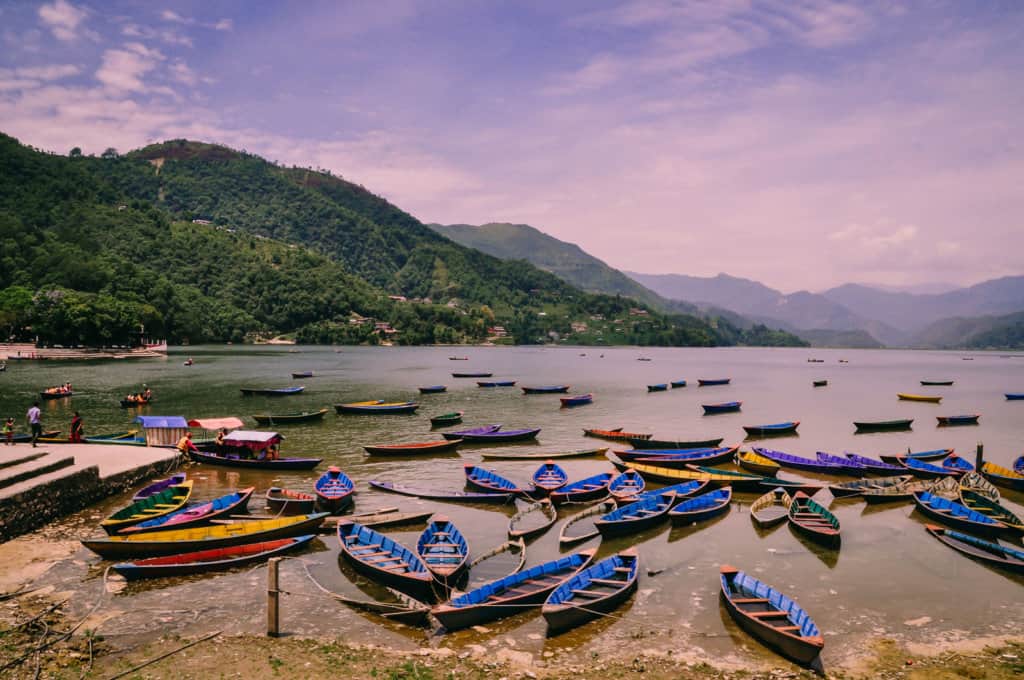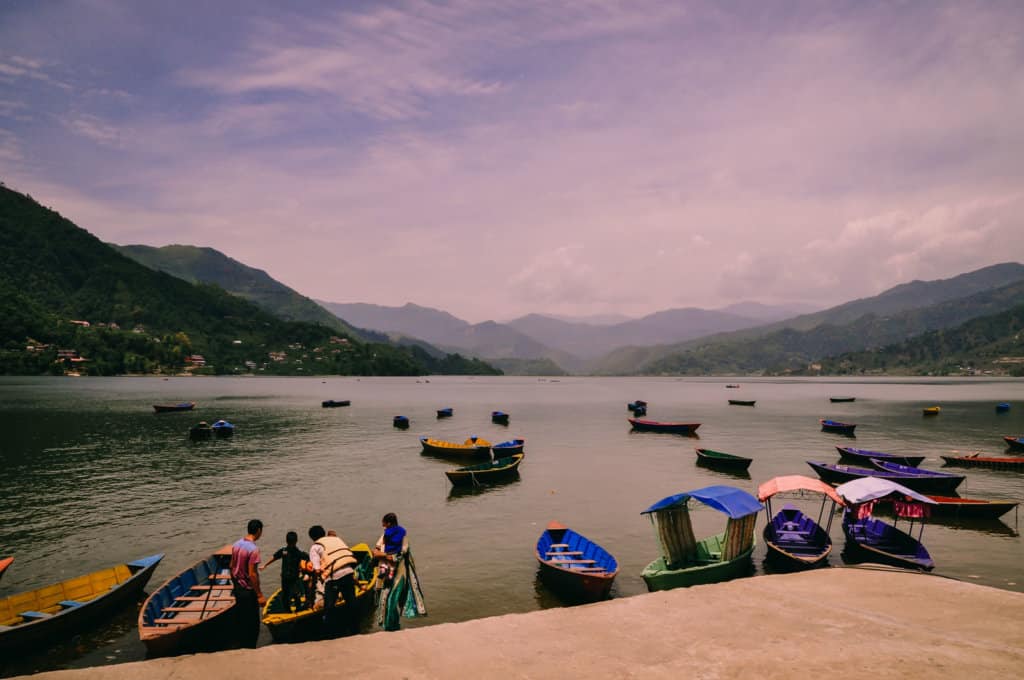Hike | Annapurna | Nepal
Hiking the Annapurna Circuit in Nepal
Text | Anninka Kraus
Photography | Tobias Kraus

Nepal
The Annapurna Circuit is a 16-day trek through the Annapurna Mountain Range in central Nepal, encompassing tropical and arctic climate zones, the 5416m high Thorong La Pass, which touches the edge of the Tibetan plateau, stunning views of peaks over 8000m high, and incredible cultural diversity.
The starting point of trek is Besisahar. The town in the Marshyangdi river valley of the Lamjung District of Nepal, is a 5-hour drive from Nepal’s capital Kathmandu, and lies at 760m, with a sub-tropical climate, and a population of ~25000.
jump ahead.
16-day Annapurna Circuit Itinerary








what to expect.
Hike through Nepal’s unadulterated and peaceful beauty against the magnificent backdrop of the Annapurna Mountain Range
Adorable baby yaks, small pretty temples, and countless prayer mills
Houses traditionally built of stones sourced from the riverbeds and cheerfully decorated with prayer flags fluttering in the wind
Breathtakingly beautiful views as you cross the Thorong La Pass at 5416m and of pastoral mountain hamlets and beautiful lush green terraced fields
day 1
Besi Sahar - Bhulbhule
We recommend to hiking the Annapurna Circuit anti-clockwise! The altitude gain this way is slower, and crossing the more than 5000m high Thorong La Pass is safer this way. We did Besisahar-Bulbhule-Germu-Tal-Timang-Dhikur Pokhani-Thorung Pedi-Manang-Yak Kharka-Thorung Pedi-Ghorepani-Muktinath-Jomoson-Tatopani-Ghorepani-Ghandruk-Pothana-Phedi-Pokhara.
We chose the second most popular season for hiking the Annapurna Circuit – April to May. Most of the snow is gone at this time. There is a regular fog at low altitudes during this season, but the skies are crystal clear higher up on the trail. The end of May signals the start of the monsoon season.
We met Harka, the manager of our Nepali tour company, and Dawa, our intended porter-guide for the trek at the Tings Lounge Hotel in Kathmandu. About the time that Harka started giving us some last-minute advice for the impending ordeal, or the ‘16-day Annapurna Circuit’ as he called it, I began to question my sanity. What was I doing setting out on a hike that takes longer than a fortnight and crosses the Thorong La Pass at 5416m elevation?
Dawa stood there smiling at me encouragingly, but observing his rather slight build, I wondered whether this was for his own benefit or mine. I was seriously worried he would not be able to carry the 30 kilograms of our belongings, strapped across his head and shoulders, to above 17000 feet.
The road from Kathmandu to Besisahar, the starting point of the trek, was peppered with a vast number of deep potholes, and by no means designed for the sheer volume of ancient trucks and even older buses filled to overflowing. Our driver sounded the horn almost continuously on the 5-hour drive, while in the back we alternated between suffering in the stuffiness of closed windows, or enjoyed choking on the black exhaust fumes and light brown dust gathered in billowing clouds behind the vehicles all around us. I feel like I have never breathed heavier air and I struggle to imagine living here, breathing this air day in, day out.
Besisahar was nothing more than a noisy dirt road lined by unsightly, mostly rundown houses, and we saw no reason to stay the night. Instead, we convinced Dawa to start us on the first leg of our hike, a day early. We were met with a heavy downpour the moment we got out of the car and I wondered whether the monsoon season was confusing summer with spring. Oddly enough for a porter-guide, Dawa was only equipped with a daypack. This was much too small for the baggage of three people, and he also had no carrying strap to spread the weight across his head and shoulders as most porters do. Unfortunately, my concerns about Dawa’s smallish build were confirmed when he swapped his pack with Tobi’s, shouldered 15 kilograms (half the planned weight), and promptly collapsed. We rearranged the weight between our packs, and bought a strap and rain cover for Dawa’s daypack.
After that we were ready and set off dressed in rustling raingear, along a dirt road also frequented by cars and motorbikes, alongside the Marsyangdi Nadi River towards Bhulbhule. Other porters jogged past with enormous packs, seemingly oblivious to their weight, while Dawa crawled along at snail’s pace and confessed to being “somewhat out of shape” during our first break. Terrific! Tobi and I had struggled through four runs per week in atrocious humidity, in the subtropical climes of Southeast Asia to prepare ourselves for this hike, and it is our porter who is in strife. However, I had the strong suspicion that once we reached higher altitudes, Dawa, who had grown up at 2, 800 metres elevation, would outsprint us all. At least that is what I hoped. In the meantime, Tobi and I decided to carry most of our own stuff for the following few days.
When the rain cleared, the landscape was absurdly idyllic, except for the SUVs hurtling past and the school busses painstakingly wheezing uphill. Small villages dotted the slopes running down to the stream and we followed the riverbed, crossing twice on rickety suspension bridges. The rotten wooden planks of the first bridge groaned and creaked, and I held my breath while a dozen chattering school kids in uniform squeezed past me jumping up and down, surely just for the fun of seeing my pained expression. To me the planks appeared to be tacked together in no apparent order and scarcely attached to the rest of the bridge’s flimsy construction. The whooshing water down below appeared forebodingly close.
We made it across safely, and after a 2.5-hour hike, which could have easily been managed in two hours, were it not for a struggling porter, we arrived in Bhulbhule, a collection of modest teahouses along the riverbank. All accommodation on the Annapurna Circuit was described to us as „simple but cosy “, yet I was uncertain what that implied exactly until we entered one of the guesthouses. The common room was plain and equipped with wooden dining tables, benches, and a TV, yet indeed radiated snugness. The balcony facing the riverbank was also a pleasant place to enjoy a cup of Nepali tea.
Sadly, that was all the cosiness I could find. The nine guest rooms, including twin rooms and dorms located on the first floor, consisted of a wooden construction with a corrugated iron roof and glassless windows. We made the acquaintance with our neighbours through huge gaps in the wooden planks of the separating walls. Mice droppings spread across our two rock-hard plank beds, and the squatting toilet was a shack at the end of the balcony with no lock. The shower located in the garden featured a hot water system so maddeningly complicated that we showered quickly under a cold trickle. But hey! At least there was a leech in there to keep you company. All that a steal for only $3 a night!
At least, the veggie curry, egg fried rice, and momo for dinner was delicious and plentiful. Dawa took great care to order our dinner immediately on arrival (breakfast was likewise ordered the night before), out of habit he explained, as this was necessary to avoid customary long waits for meals especially in high season (which runs from October to November).
Later we lay on our uncomfortable wooden plank beds listening to a concerto of rain drops splashing on the roof competing with the deafening noise of the river rushing past, which together mercifully drowned out the sound of scurrying mice. A small gecko was stuck to the ceiling above my head and I lay still, willing it to catch all the mosquitos, moths, and bugs in our room. And the neighbours’ come to think of it. Those gaps in the planks would allow passage to any animal smaller than a kitten.
Despite my worries I fell asleep, and slept until two in the morning, when I woke chilled to the bone. Looking down, I cursed myself for falling asleep in my sleeping bag liner. Without my headlight nearby, I rummaged through the plastic bags at the bottom of my pack to retrieve my sleeping bag, the rustling waking everyone back up.
track details.
Route: Besi Sahar (760m) – Bhulbhule (840m)
Time: 2:30 hours
Accommodation: Heaven Guesthouse & Restaurant
Info: Daily expenses for two (accommodation in double/twin rooms – 100-500Npr – and 3 meals): 1800Npr-5000Npr (higher up is more expensive) / Exchange rate at the time: 100Npr = ~0,88€ / ~1,14US$
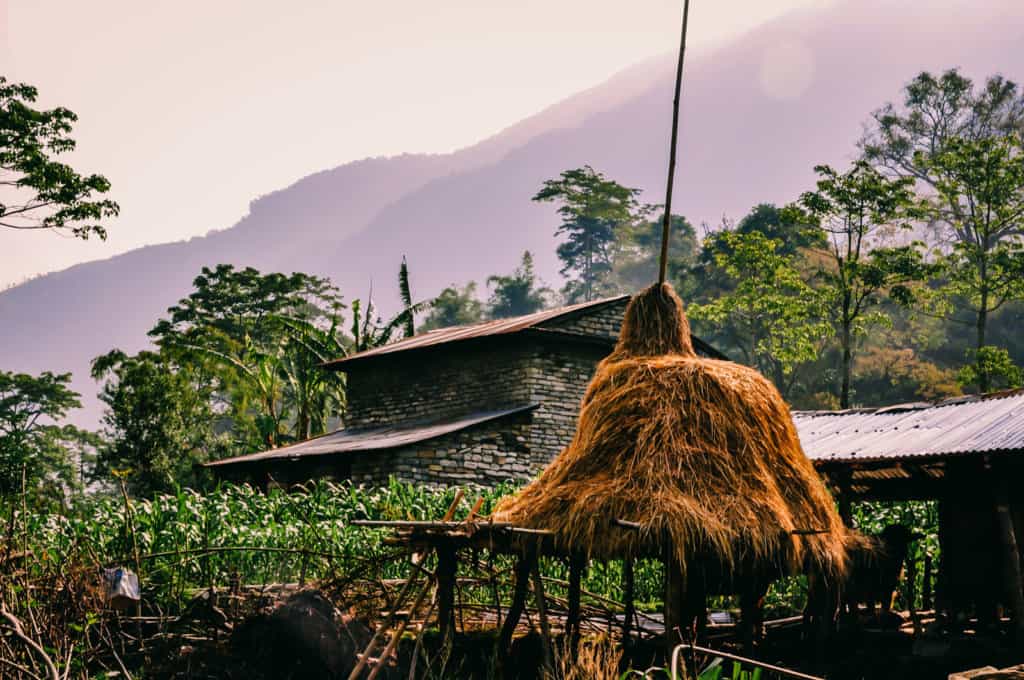
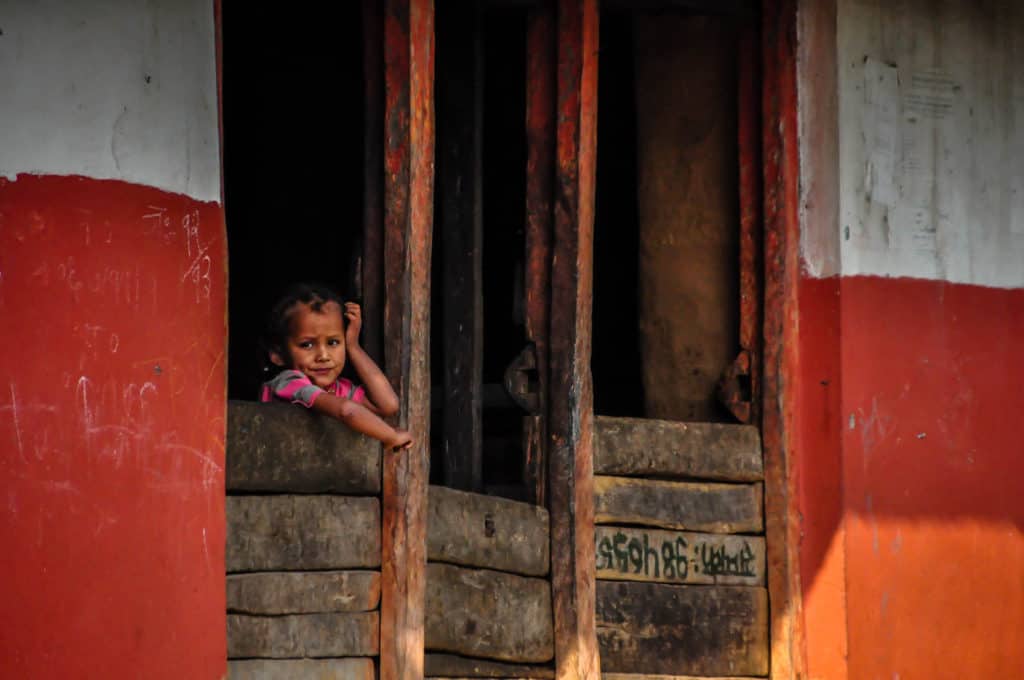
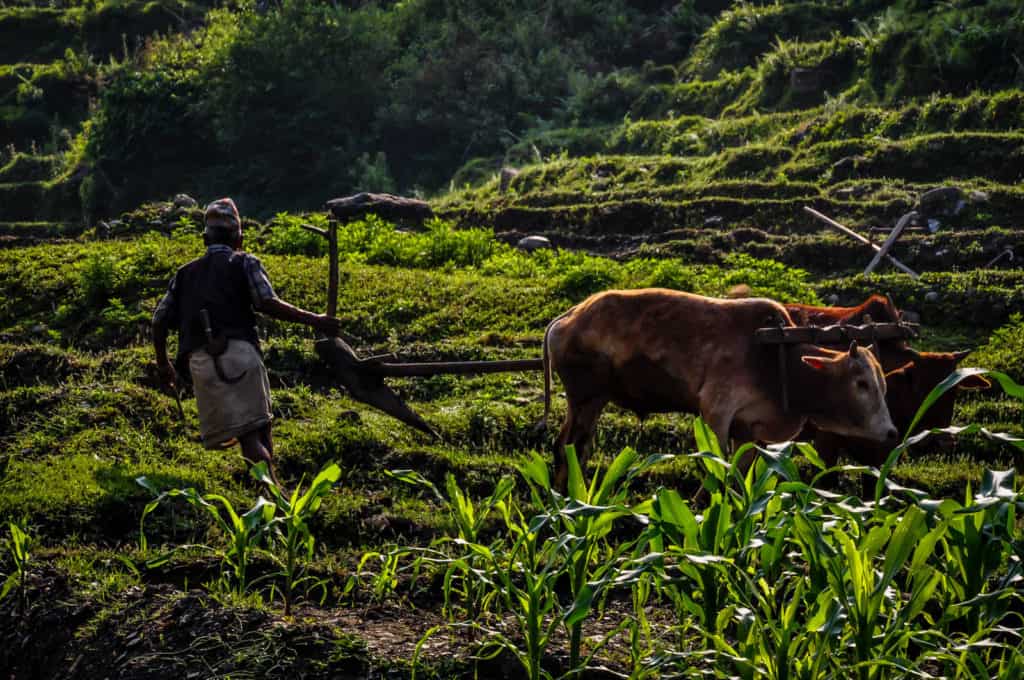
day 2
Bhulbhule - Ghermu
Despite the night-time hunt for my sleeping bag, we woke up well rested at 6:30 am and watched the grey dawn gradually dissipate as the sun scrambled up the surrounding mountains. I passed on another shower with the leech, but splashed my face with cold water, making it to the balcony in time for breakfast. The valley’s green slopes, unspoilt and lush, were bathed in a weak, but warm sunlight and the heavy, earthy smell of soaked soil, nature’s bounty of the previous night’s rain, lingered in the air.
We set off from Bhulbhule under blue skies, both carrying more weight than the previous day, and Dawa hence less. Hiking upriver on field roads and through tiny sweet hamlets, we were greeted with a cheerful Namaste (hello) from all sides. After a 2.5-hour hike we arrived in Bahundanda at 1310m in 30-degree heat, shortly past 10am. To our surprise Dawa announced that he had planned to spend the night here. Not keen to pass ten hours in a featureless teahouse, we agreed on a 45-minute break instead. We took that time to drink in the brilliant panorama of terraced corn, wheat and rice fields, and small mountain villages that adorned the steep slopes like dabs of paint against a magnificent mountain backdrop.
When we set off again on a beaten track down rugged steps we were rewarded with our very first glimpse of snow-capped peaks. We passed the village Khorikhet and crossed the river on another suspension bridge to reach the bottom of the valley. From there we faced the tiring climb up the opposite hillside to Ghermu at 1310m. Luckily a constant array of beauty propelled us up the hill, as we took in multiple waterfalls, geckos aplenty, chickens double the size of our domestic chicken making them look like giant feather balls, and herds of goats with their young being shepherded downriver.
At 1.15pm we arrived in Ghermu where Dawa made a beeline to the very first accommodation, the Crystal Guesthouse, giving us no chance to suggest walking on again. He was of course right that we should rest, and we were lucky to have him. Every year hikers die from altitude sickness in their attempt to cross the Thorong La Pass and it is not a good idea to reduce the number of necessary acclimatisation days too much.
Our room was somewhat brighter and friendlier than the last, and could have been quite agreeable, were it not for the two plump maggots tossing about on the floor next to my bed. The owner assured us of a warm shower thanks to a gas tank, but the stubborn installation spat out no more than a weak stream of cold water from the hot water tap. The coffee made from organic beans, however, was a welcome change to the usual Nescafe instant coffee. Daily life in the tiny village passed at a leisurely pace and the locals were genial and welcoming.
We stopped and listened to a man sitting cross-legged in the sun, playing a stringed instrument that looked something like a violin, and its unusual sound together with the tune he played suited this altogether pretty place. We took a stroll through the village and saw a girl scrubbing clothes at the communal water supply, white foam piled high. A few doors down an elderly woman leaned against the doorframe of her cottage and spun black yak hair into wool, tidily coiled spools neatly lined up and waiting to be manufactured into blankets and warm jumpers.
Here on the Annapurna Circuit, I was happy to finally discover my initial naive notion of Nepal – the tranquillity. Without the traffic, furiously blaring horns, pollution, and dust of Nepal’s capital I even imagined the constant tickle in my throat, the one I’d been unable to shake since Kathmandu, was slowly starting to abate.
track details.
Route: Bhulbhule (840m) – Ghermu (1310m)
Time: 5:45 hours (incl. 45min lunch break)
Accommodation: Crystal Guesthouse
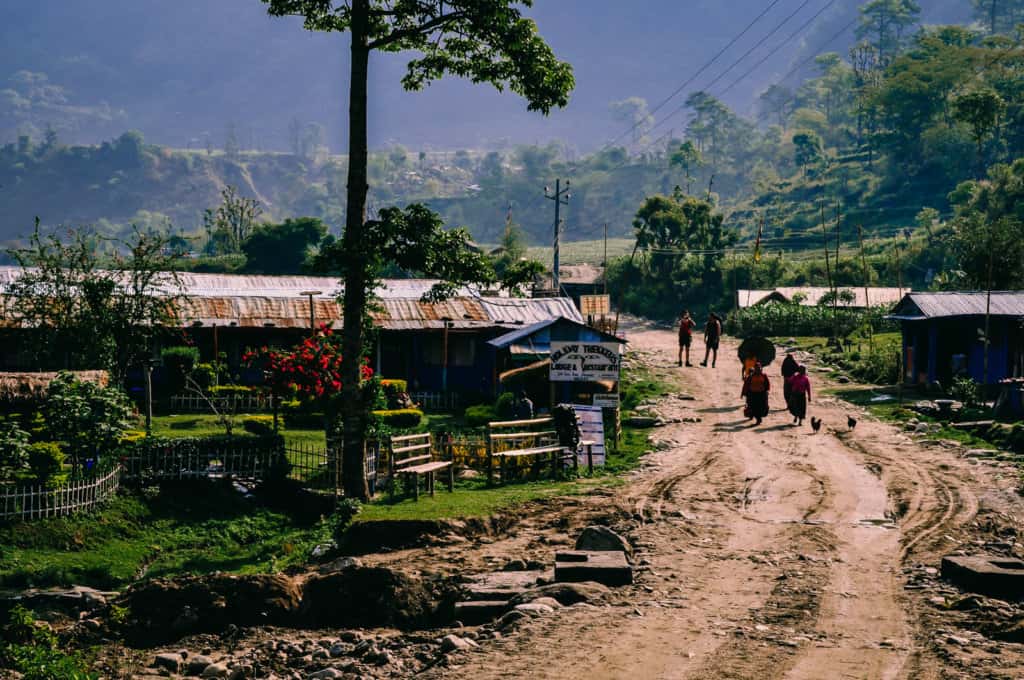
day 3
Ghermu - Tal
Despite enjoying the tranquillity of the village, my evening was marred by coming alarmingly close to having a serious nervous breakdown. Before even daring to turn off the lights, I had to pick twenty-five fat, white maggots off my bed and the floor. I threw them over the side of the balcony in the hope that one of the plump chickens on the lawn below would gobble them up. But unfortunately, after going to bed, and lying there in pitch-black darkness, it didn’t take long before I heard them.
There were more, and they were dropping from the patched-up ceiling onto the floor below. Whimpering like a child, I got up, turned the lights back on, and threw another handful out the door. I moved my bed into the middle of the room where there were fewer gaps in the ceiling. This however, regrettably also brought me closer to the hyperactive spider running up and down the wall. In all my life, I would have never thought I would choose a spider over anything, and yet here I was. If you are planning this trek and are just ever so slightly disgusted by insects, beware!
I’ve rarely anticipated a morning so eagerly, gingerly crawling out of my sleeping bag to avoid our loathsome roommates, of which there were another twelve wriggling about. With strength of mind and partially distracted by the glorious view, I managed to eat rolled oats for breakfast, somehow without imagining them to be maggots. From Ghermu the path descends some 200m in elevation, crosses to the opposite riverbank on an iron swing bridge, and continues on a stretch of gravel road also frequented by SUVs. Three waterfalls flanked the later part of today’s leg, their frothing, white spray shooting up high into the air. Green mountains towered above us as we courageously scrambled up the river valley on stony paths, at times on all fours, trying to keep our balance. We took a short rest in Chamje at 1430m. The thermometer hit 30 degrees, and in a futile attempt we tried to apply more suntan lotion on top of the sweat pouring down ours foreheads.
After Chamje the trail crosses the river once more on a swing bridge beautifully decorated with prayer flags. Stepping off on the other side, we found ourselves in a large field of marijuana growing wild like weeds. The two guys ahead of us grinned like Christmas had arrived early and were busy replenishing their personal supply…generously. Stuffing armfuls into their packs, they were gathering enough for a group of twenty, not two. During our last steep ascent before reaching Tal at 1700m, three guys with poles raced past us. They were so fast that I was speechless in admiration as we quickly lost sight of them ahead. Admittedly, I was a little speechless for lack of breath anyway. I wondered whether they were also celebrating an early Christmas, and that if this is what marijuana does that to you, maybe I should try it?
My musings were short lived when less than ten minutes later we passed two of the trio doubled over by the side of the track, visibly exhausted, and shortly after caught up to the third, who was by then using his hiking pole much the same way my granddad uses a walking stick. The large settlement of Tal, consists almost exclusively of teahouses and restaurants, spread out along a wide sandbank, the extension of a riverbank, where the water has deposited sediment, smooth pebbles the size of soccer balls, dark grey sand, and silt. Our first stop was a Safe Drinking Water Station in the village centre to replenish our water supply for 40Npr per litre.
It is cheaper to obtain water from the wells at teahouses, but this water needs to be purified to make it safe for drinking. We use dioxide tablets that have worked perfectly for us. They however don’t get rid of the sand, pieces of leaves in various stages of decay, and one time what looked like the legs of an extended family of ants. We’ve used our clean shirts to filter out the debris, which also works quite well. I absolutely refuse to imagine the horror of contracting a stomach virus when the only available relief are squatting toilets. I’d much rather deal with the chlorine taste from the dioxide tablets, which surprisingly still manages to taste better than the Coca-Cola dispensed from Subway fountain machines in the States.
The chlorine killed all invisible tummy bugs wriggling about in our water, but sand, pieces of leaves in various stages of decay, and what looked like legs of an extended family of ants were still floating around. Tobi suggested filtering the water through his T-Shirt and because I couldn’t think of a better solution I reluctantly conceded but insisted he uses an unworn one, lest our water tastes of orange, chlorine and sweat.
As we had lunch at the Tilicho Hotel, our accommodation for the night, the sky turned dark with heavy rain clouds gathering across the mountain peaks, quickly moving towards us. Within minutes the valley and riverbed were wreathed in a heavy mist, and the rumbling thunder announced an imminent storm. I loved this guesthouse for we were treated with a warm shower, a wonderful dinner with freshly baked buckwheat bread, and most notably a clean room devoid of animals. Dawa explained to us over dinner that many vegetables and grains are cultivated in this region, in particular potatoes, corn, cabbages and pumpkin. He pointed out that apple trees were gradually, and with increasing altitude, replacing the banana trees, which sadly meant presumably no more banana pancakes for breakfast.
track details.
Route: Ghermu (1310m) – Tal (1700m)
Time: 5:45 hours (incl. 30 min break)
Accommodation: Tilicho Hotel
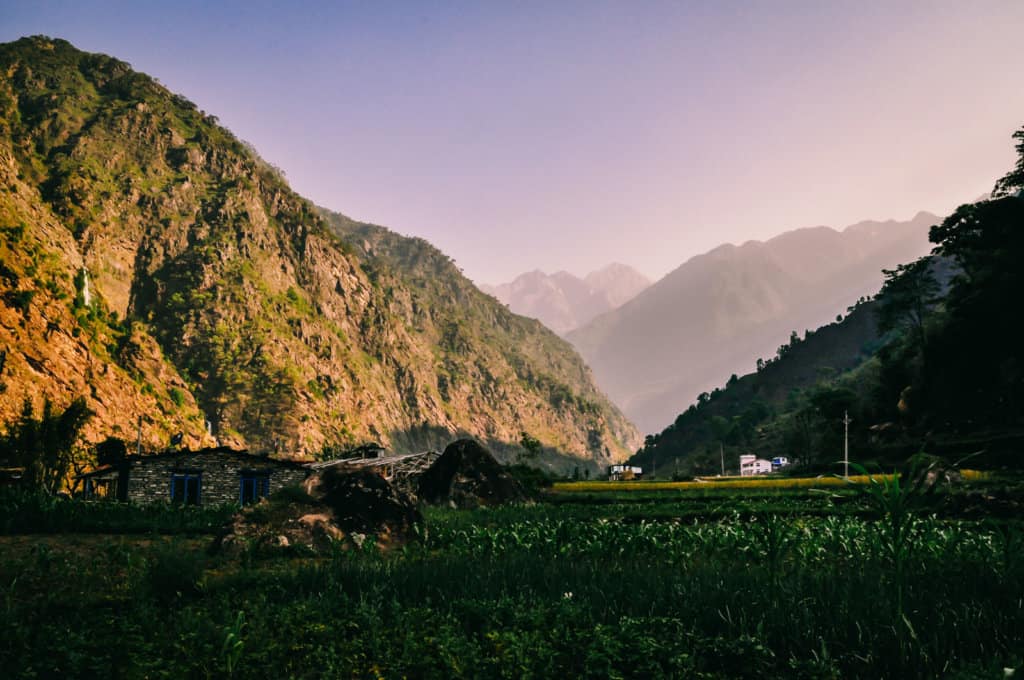
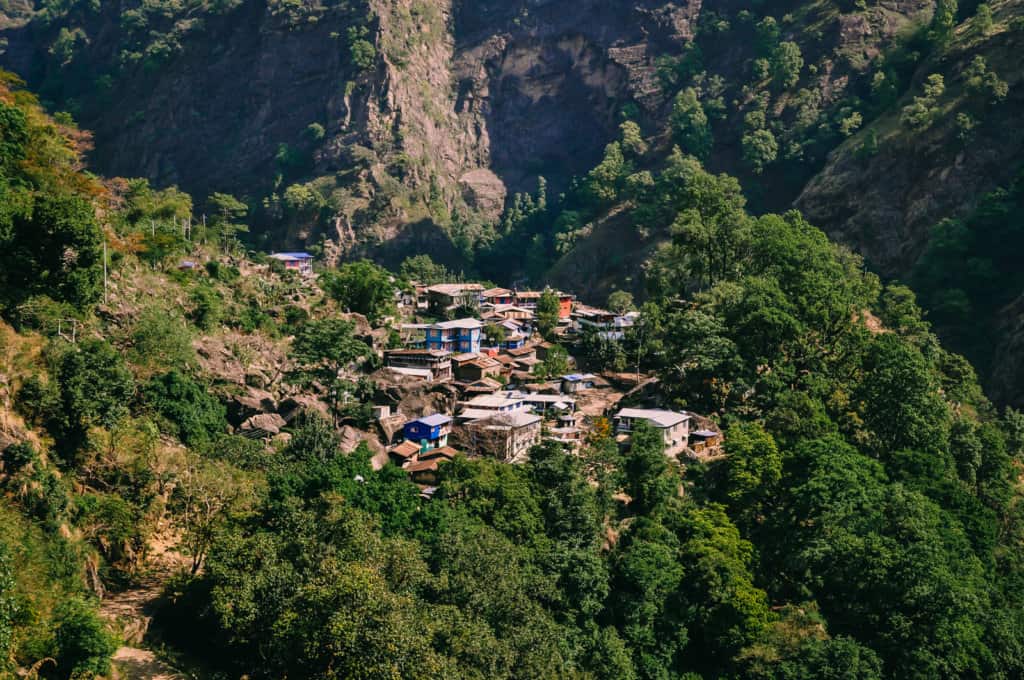
day 4
Tal - Timang
The path that continued upstream, winding along the right riverbank to Chhajo was considerably more challenging but also far more rewarding than the dirt road on the left bank frequented by SUVs. The SUVs are mostly driven by locals who use them for transportation whenever possible. As much as I understand that locals prefer driving cars to a strenuous ascent on foot, the landscape has suffered for it, and some of its tranquillity is lost in the exhaust fumes and noise.
At Chhajo we had to cross over to the left riverbank, and walked the rest of the way to Bargarchap at 2160m on the gravel road, lost in the dust cloud whirled up by traffic. Here Dawa got our travel permits stamped at the local police station, and we continued on. Off the road, the enchanting scenery bounced back in full force. Fragrant pine and spruce forests were full of chirping birds and crickets, small baby blue butterflies dancing over white blossoms, and forest strawberries.
I was afraid we’d walked too far and into a fairy-tale land when we came upon a mare and its new-born fowl grazing on a small clearing. What next? The Seven Dwarfs? I was provided with a good dose of reality when shortly after the trail led up steeper stretches on sandy ground, and I struggled to maintain my footing. We took our longest lunch break yet on a terrace outside the Peaceful Hotel & Restaurant in Danakyu at 2300m, revelling in the view of the midday sun reflecting off the surrounding snow-capped mountains.
Today we also saw the tallest peak on this hike yet – the peak of Manaslu rose into the sky at an intimidating height of 8,136m. For perhaps the first time, gazing up at this impressive mountain, I could relate to the fascination mountaineers harbour for these giants reaching up into the death zone (death zone is the name given to altitudes over 8,000 metres, where there is not enough oxygen for humans to breathe). Luckily, gazing at this impressive panorama whilst eating pancakes for breakfast seemed to satisfy my curiosity for such altitudes.
By 1:30pm we reached our final destination for the day, Danakyu at 2750m. Just in time too for like the day before, slate grey rain clouds gathered deep inside the valley, shrouding the mountain range in an impenetrable mist. A deluge of rain came shortly after, accompanied by deep peals of thunder, and a sudden drop in temperature, making the teahouse’s invitation to use their warm shower ever so welcome.
track details.
Route: Tal (1700m) – Timang (2750m)
Time: 5:50 hours (incl. 50 min break)
Accommodation: Oasis Guesthouse and Restaurant
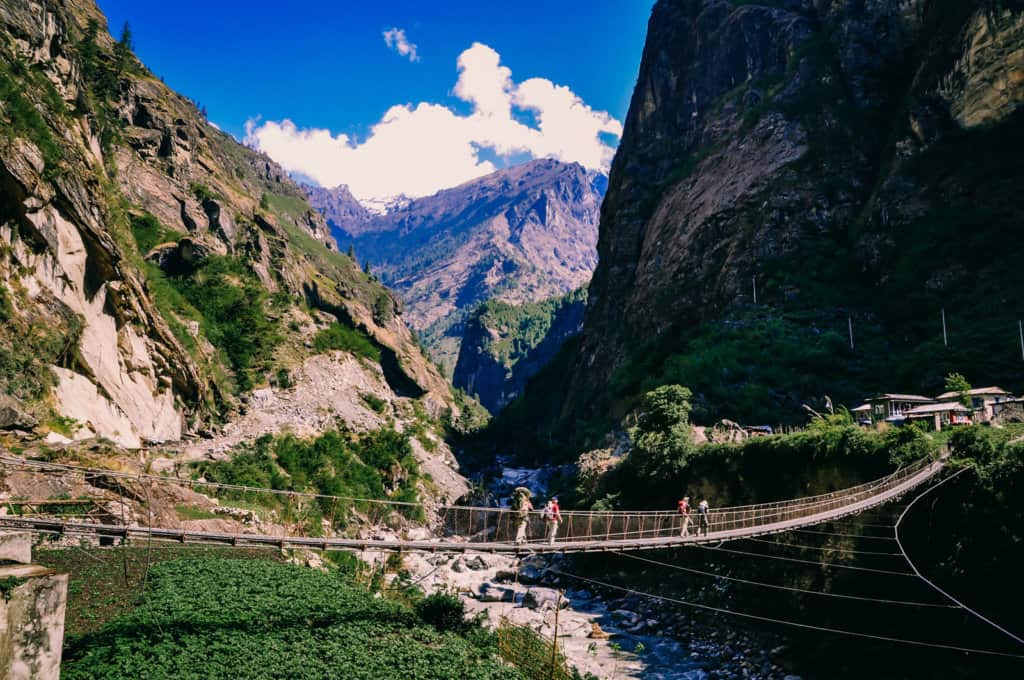
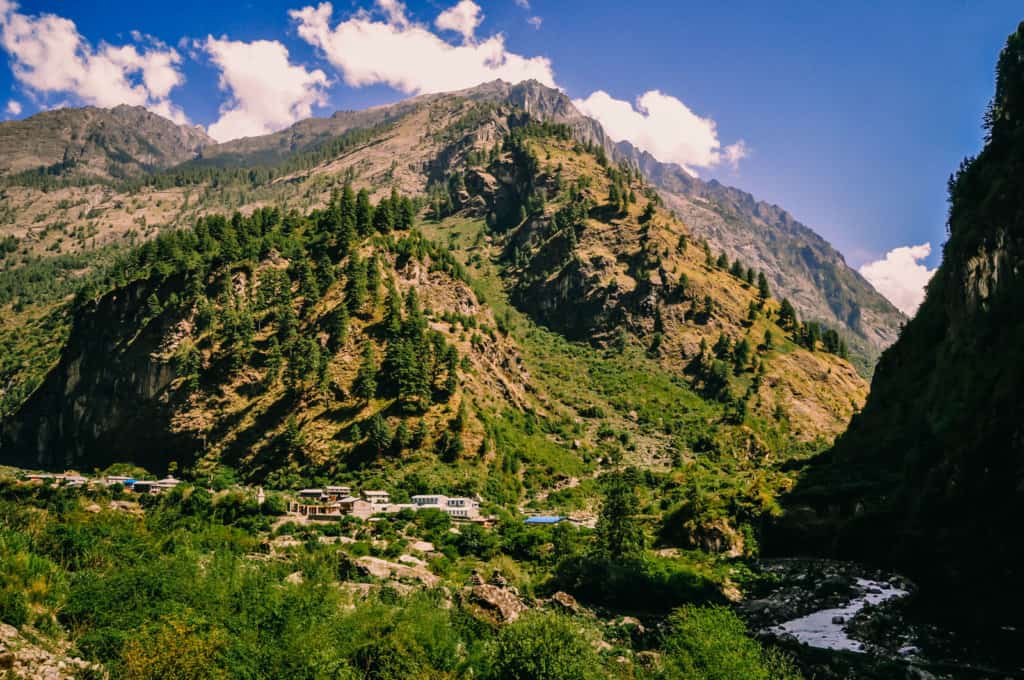
day 5
Timang - Dhikur Pokhari
We decided to eat our breakfast outside. It was warm in the sun and the scenery was gorgeous with white fleecy clouds floating across the sky, and a clumsy new-born fowl teetering about on unsteady legs. Admittedly the other reason we went outside was to escape the constant sounds of sniffing and spitting coming from the kitchen, an unfortunately common habit in Nepal.
The first part of today’s hike followed the Marsyangdi Nadi River upstream through charming mountain hamlets and conifer forests, past Latamro and Tarchock, and onto Koto and Chame. Chame, at 2670m, was the largest village on the circuit yet and offered plenty of supplies for hikers including outdoor equipment, toilet paper (it’s good to have a supply because none of the guesthouses do), and for myself Knorr Cream of Mushroom Soup. We were ahead of our itinerary but didn’t stay the night, instead hoping to spend the day on an additional leg, a less frequented trek, towards the end near Manang.
Mid-morning Dawa stopped us for lunch in Taleku at 2720m just as the sun disappeared behind the clouds. I shivered in the chilly breeze, and watched cute mules, completely unperturbed by the cold, stop at a trough outside the guesthouse, slobbering icy water. All day long colourfully adorned herds of these animals nimbly skipped past us, never floundering as they rushed downhill. They were far more pleasant companions than the motorbikes jolting past us, engulfed in thick clouds of dust.
Dawa told us that the entire route was untrafficked, until three years ago when SUVs and motorbikes started to appear within easy reach of the mountain pass. I was relieved every time we withdrew to an all-hiking trail, away from the exhaust fumes, and watched with mixed feelings at the new road being blasted into the opposite steep cliff face. It wasn’t tourism destroying the gorgeous scenery– at least not directly, because as Dawa pointed out the vehicles were almost exclusively used by locals. I realised that in a few years’ time, these little mountain villages may be smothered in a lingering smell of raw, unburnt gasoline and the herds of sweet mules may be irrevocably gone. Yet I do understand at the same time the hypocrisy in my observation – I quite enjoy driving to work and stopping at one of the well-stocked supermarkets on the way home. But from a hiker’s point of view it is a shame and will surely change the Annapurna Circuit trek into a very different experience in the future.
From Bhratang to Dhikur Pokhari the path skirts the riverbank, veering up and down relentlessly, along water carrying vast quantities of sediment and tinted an intense slate grey colour. Large rock boulders sat in the riverbed, polished to smooth balls, and the bare steep rock faces were smooth as mirrors, surely the work of a glacier that has long since withdrawn up the valley. Soft sedimentary layers were visible along the path, exposed by landslides due to severe weather, or blasted off the mountainside.
Close to Dhikur Pokhari we met an Israeli couple, who were slowly recovering from a nasty stomach bug. Considering the cleanliness, or rather lack thereof, of some of the dishes and cutlery we used, plus the pitch-black, dirt-encrusted fingernails of the cook who kneaded our momo dough, it was a miracle this hadn’t happened to us yet. If you are someone who normally carries hand sanitizer and expects kitchen staff to be similarly hygiene-conscious, you will likely starve on this trek.
The Kamala Guesthouse promised a warm shower, but again it was no more than a tiny trickle of lukewarm water at ambient air temperatures close to freezing. On a more positive note, the place was new and treated us to a snug room timbered with untreated wooden planks, and thick blankets. A large wood stove in the cosy dining room drew in chilled hikers and a dozen locals alike, as by now night temperatures dropped below freezing point.
track details.
Route: Timang (2750m) – Dhikur Pokhari (3060m)
Time: 6:45 hours (incl. 45 min break)
Accommodation: Kamala Hotel
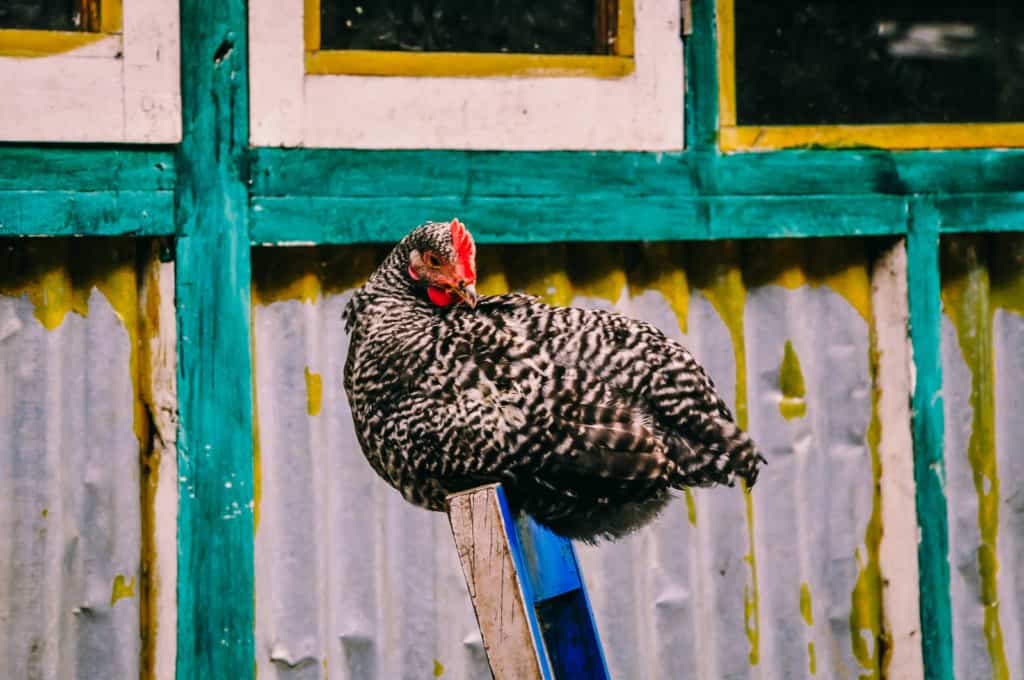
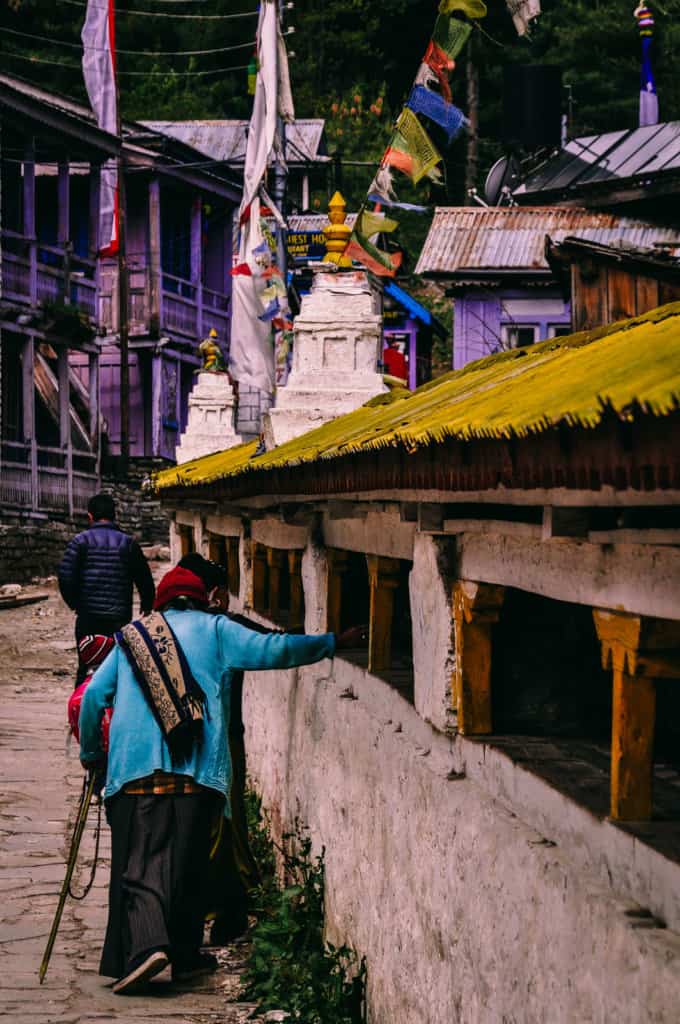
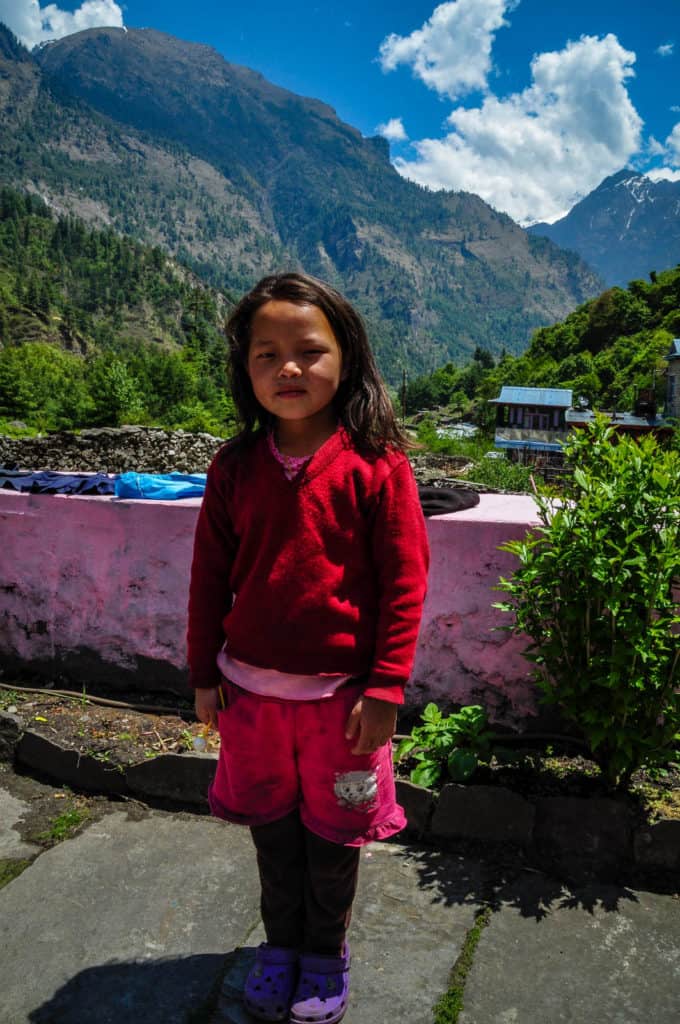
day 6
Dhikur Pokhari - Manang
Getting up at temperatures close to freezing point was painful and a rather hurried affair, as was brushing our teeth with icy water. While sitting in the frosty dining room sipping hot tea, I wondered how cold it had to get before someone fired up the wood stove. That day we agreed to walk different routes and meet up with Dawa in Humde for lunch. Setting off at 7:30 am in bright sunshine, under a cloudless sky, and wrapped up in several warm layers, we exited Pokhari.
A sign and the red-white Annapurna circuit symbol pointed us to the right, in the direction of Upper Pisang at 3300m. Unknowingly we had picked the more challenging trail via the small mountain village of Ghyaru at 3670m. Dawa on the other hand planned to follow the dirt road on the left riverbank and re-join the hiking trail on the opposite bank of the Marsyangdi River just before Manang. The pine forest smelled sweetly of resin, and the beauty of the 360° panorama, abundance of new-born fowls, calves, and baby goats tipsily following their mothers on spindly legs, was mind-boggling.
In Upper Pisang, perched on the southern flank of the Pisang Peak, we briefly considered crossing the river as we saw hikers on both sides of the valley, but the motorbikes that tore along the road on the other side reinforced our decision to stay on the hiking trail instead. The homes along the riverbank of Upper and Lower Pisang were traditionally built of stones sourced from the riverbed and cheerfully decorated with prayer flags fluttering in the wind. We met only a few other hikers and Sherpas who guided mules carrying heavily laden baskets downhill. Lavishly decorated prayer mills were dotted along our path, at which Dawa had explained to us you can make a wish or mutter a thank you while setting the wheels in motion.
After passing the most splendid row of prayer mills yet, we crossed a swinging rope bridge equally adorned with colourful prayer flags and spanning a deep ravine, to start the tough climb on the other side, along a zig-zagging path, slowly increasing our elevation. I crawled for the last part, up the near vertical slope, gasping for air in the thin atmosphere. I suppose we could have paused for brief rests, but we both prefer shorter, more intense ordeals to drawn-out ones.
A monastery sat enthroned above the valley, and the village of Ghyaru was made up of densely packed squat, flat-roofed stone structures. I sat on a wall and refused to move for the next quarter-hour, catching my breath, utterly enchanted by Nepal’s unadulterated and peaceful beauty against the magnificent backdrop of the Annapurna Mountain Range. The houses here were built of stone slabs with small section of painted wood, making the whole town appear grey, though no less impressive. There was an abundance of prayer flags, woven traditional costumes, and a genuine openness of its people with heartfelt smiles all around, and a friendly interest in us.
When Dawa first bombarded us with questions like ‘Why are you not married?’ (yes, why has nobody proposed to me yet?), ‘You have kids?’ (no), ‘Why do you not have kids?’ (think of the poor fellas), and ‘You’re old not having kids?’ (thanks for pointing that out), I was dumbfounded. You don’t ask a stranger, a shy introvert at that, intrusive questions to which they themselves haven’t yet figured out the answer. After days in which I barely contained the ‘None of your business!’ and ‘Did you really just ask me ….?’ outbursts that Dawa prompted with his curiosity, I realized he was just genuinely curious and interested like many Nepali we’d meet.
After leaving one of the loveliest places on the Annapurna Circuit, we passed through the village of Nawal at 3660m, and started our descent. Tired, I despaired at the thought that we were (more or less) voluntarily giving up the altitude we just laboriously gained; forget The journey is the destination mantra (not the movie) when the trail resembles a roller coaster. The path eventually emerged in a meadow, fairly level, though exposed to a piercing wind whistling down the mountainside. It turned our sweaty T-Shirts into frosty cooling elements and we arrived near Humde way past Dawa’s customary lunch time.
We could see Humde directly across from us on the opposite side of the riverbank, easily recognisable by its airstrip, however we found no bridge to cross, and so continued on. A pair of eagles circled above us in noiseless flight, yaks stood close to the trail, and we saw the peaks of the Annapurna mountains, named simply II, III and IV. Tobi may have gotten a little carried away and we now have several hundred photographs of white mountain tops, one indistinguishable from the other.
Our water supply ran out halfway to Mugje at 3300m. By the time we reached the village, I felt dehydrated to the point of resembling a shrivelled-up prune and rushed into the next best teahouse that sold filtered, boiled water for 70Npr the litre (but I would have pretty much paid anything they asked). We had a yummy cheese omelettes and chocolate bread rolls for lunch before setting off again towards Manang via Bhraka and its monastery. Twenty minutes outside of Manang we caught up with a by now worried Dawa sitting by the roadside waiting for us.
Manang towered above us, where countless teahouses are named after the nearby (a two-day march) Tilicho lake – the world’s highest lake at 4920m. A large archway marks the entrance to the village, and Dawa chose the biggest teahouses, the Tilicho Hotel, built three storeys high. Waving a key, one of the staff announced a double ensuite for us, and, thrilled like a little kid promised a Chupa Chups, I almost jumped up and down. I’m not quite sure the reason behind my disappointment because technically it was an ensuite. I guess I would have preferred a room without a smelly squatting toilet attached. Otherwise it was quite comfortable, and mercifully free of wriggling maggots, scurrying mice, or strangely hyperactive spiders.
After another cold shower, I snuggled into my sleeping bag, layered in polypropolene clothes. But my fingertips and toes remained numb. I’m strange that way. Once my perceived core temperature drops below a certain point I’m like a deep freeze – the ones that take hours if not days to defrost.
Resigned to the bone-chilling cold, we went for a longish walk through the village, browsed around surprisingly well-assorted shops, and discovered three bakeries. I read somewhere that cinnamon warms you up from inside and bought two cinnamon scrolls, which I think may now be my preferred approach to ward off the cold. Luckily we’d been spared of altitude sickness so far, but that night I woke with the most terrifying feeling. I felt like I was suffocating and no amount of breathing rapidly or taking huge gasps of air did anything. It felt like the air simply lacked oxygen. Dawa had warned us that this would happen, and after a half-hour I managed to calm myself down enough to go back to sleep.
The next morning, I discovered that Tobi had a similar experience overnight. His aunt suffers from advanced COPD and as much as I’ve sympathised with her condition, it wasn’t until last night that I got the tiniest taste of what she goes through.
track details.
Route: Dhikur Pokhari (3060m) – Manang (3540m) via Ghyaru (3670m)
Time: 8 hours (incl. 30 min break)
Accommodation: Tilicho Hotel; 24-hour laundry service: 30Npr small piece of clothing/50Npr larger piece of clothing
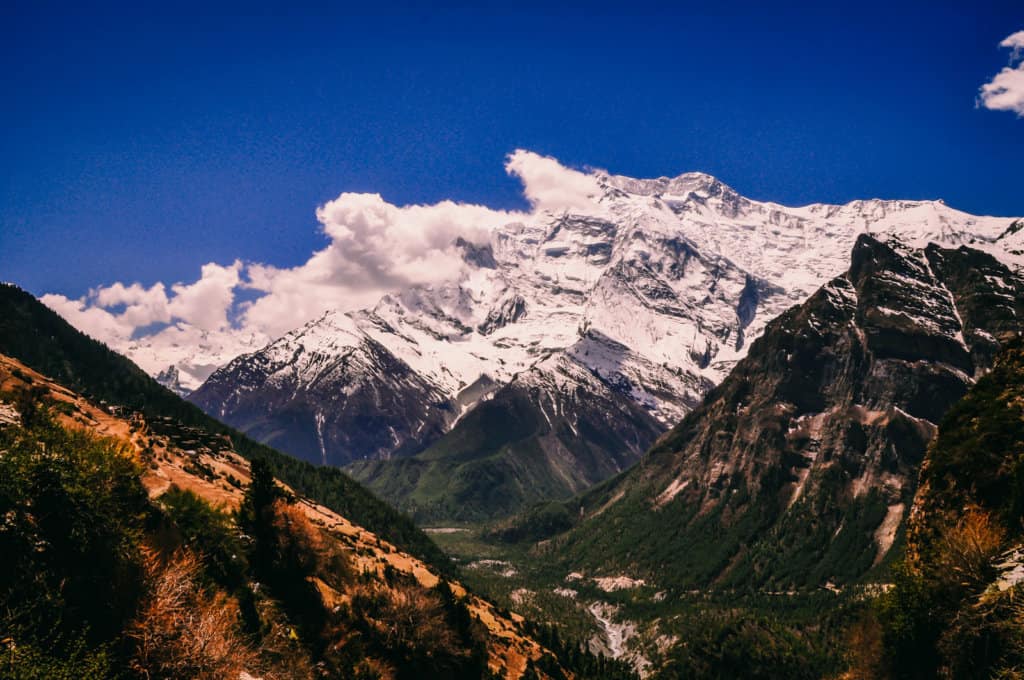
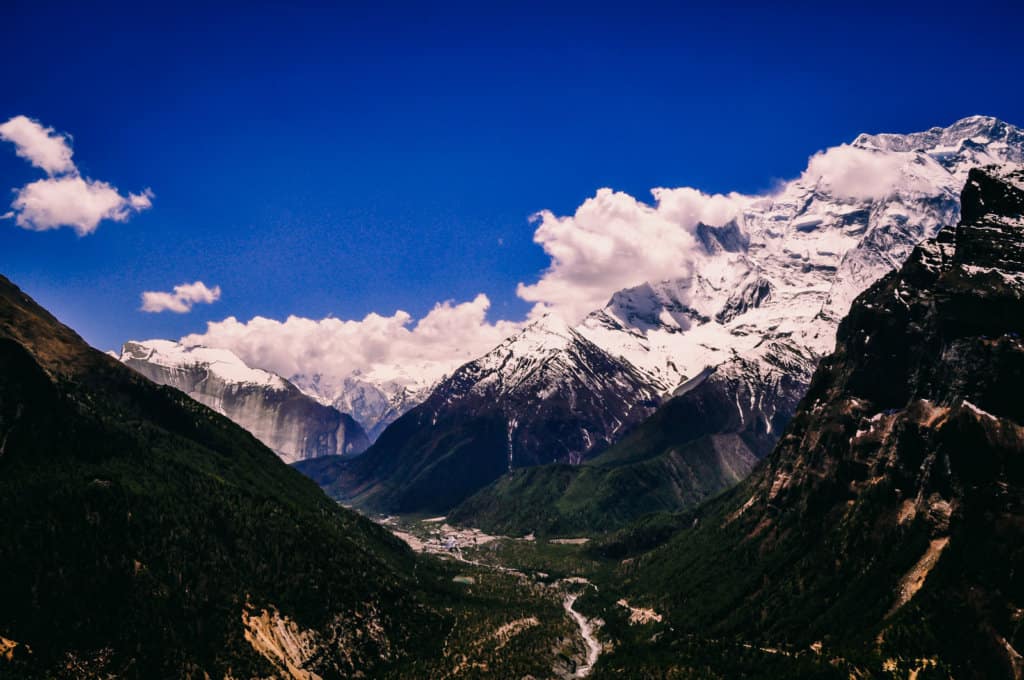
day 7
Rest day in Manang
The next day was a very lazy rest day indeed. We stuffed ourselves with cinnamon scrolls and black forest cake, and drank several pots of lemon-ginger tea and Lavazza coffee (reminder to self – Stop drinking so much! You hate the squatting toilet!). The only exercise we did was a short hike to the Ganggapurna glacial lake, which itself wasn’t all that spectacular, but we were amply entertained on the way by a large eagle circling above us, its wingspan at least two metres wide.
We napped through the almost daily downpour, large drops pounding against the (thankfully glazed) windows. There was an internet cafe at the guesthouse, the first on the trek so far, yet we felt unwilling to connect with the outside world, and instead chatted to a Slovakian couple who had started the circuit without a porter. They were completely exhausted and trying to find one now, though this far from any of the typical starting points I don’t know how lucky they were going to be.
In the late afternoon, when the water in the outside water tank had been warmed by the sun awhile, we shivered through our last shower for the next two days. Insofar as showers on this trek are concerned, you don’t ever want to enter one without flip-flops, for three reasons – leeches, dirt, and an incredibly cold floor.
track details.
Route: Rest day in Manang (3540m)
Accommodation: Tilicho Hotel
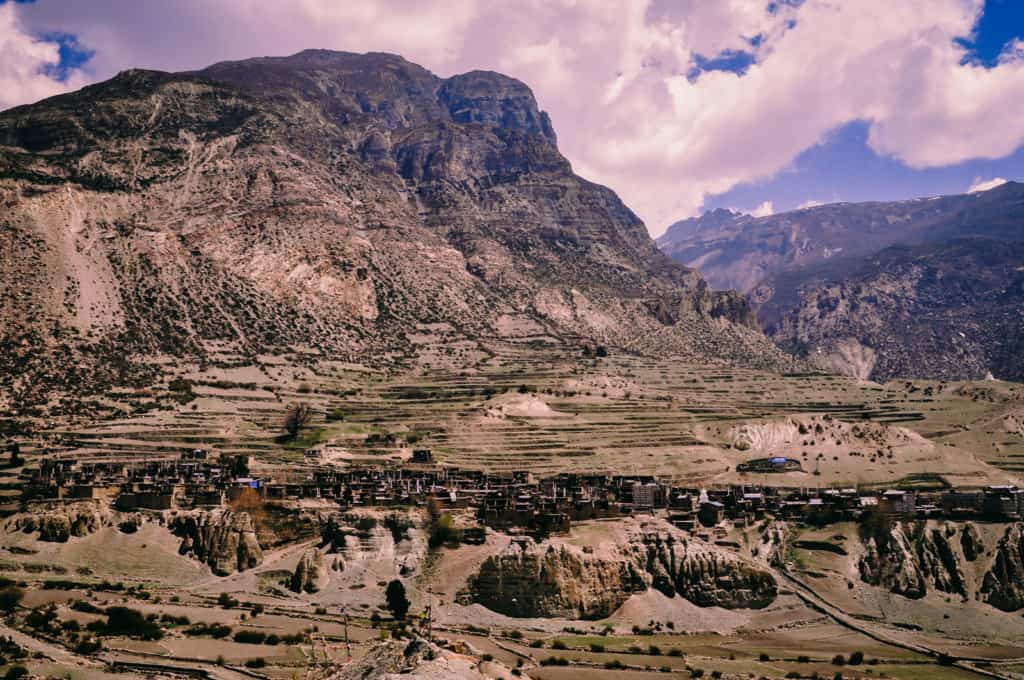
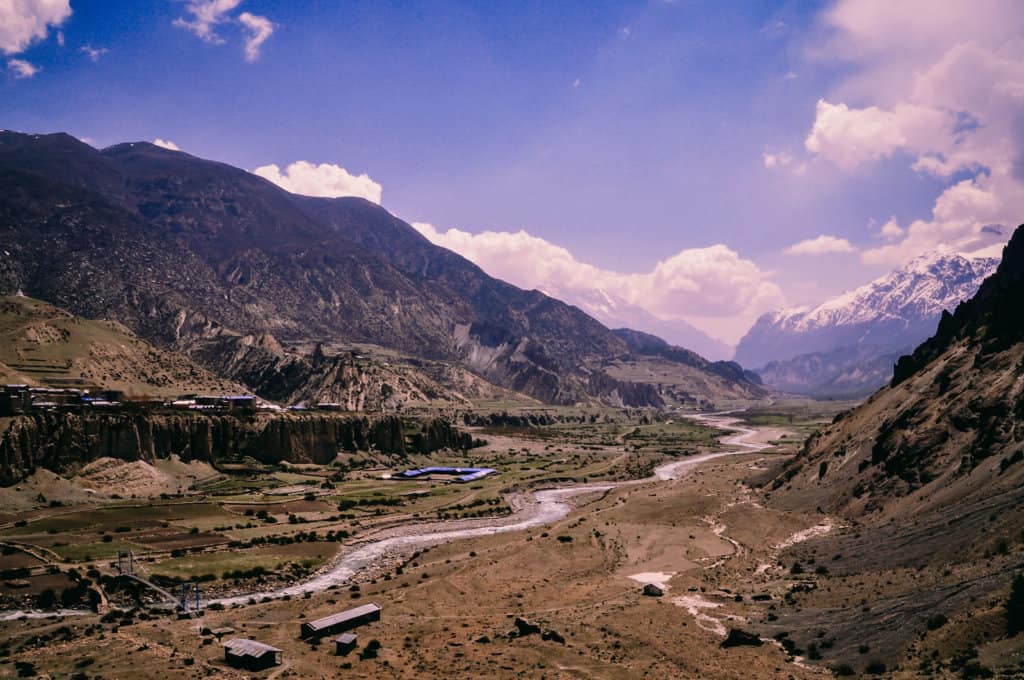
day 8
Manang to Yak Kharka
Dawa’s hesitant expression when I announced I was getting pastries from the bakery for morning tea threw me. It was only when he realised that I was paying for his that a huge smile broke across his face and it struck me again how blind we are to other people’s situations. A chocolate croissant is likely not something he can afford every day, or any day. When we bought chocolate bars at mealtimes, we always got three, but Dawa generally disappeared to eat with the other porters.
They ate Dal Bhat, the Nepali national dish, three to four times a day. It was the only all-you-can-eat dish in teahouses on the Annapurna Circuit and was always free for porters and guides. We quite liked the rice dish with spicy green soup, spinach, fried potatoes, and cauliflower but having it for breakfast, lunch and dinner would be overdoing things. Dawa ate the croissant the moment I handed it to him, and out of the blue asked me to guess his age. I laughed, and shook my head, explaining that I suck at estimating a person’s age, especially when they’re of a different race. Turns out Dawa is even worse than I am. He thought Tobi was 40 years old (he was 30) and I pleaded with him to stop before having a shot at guessing mine.
Dawa announced we were doing an easy stretch today and that it was indeed. The path led steadily but gently uphill in bright warm sunshine. We gazed in awe at the sparkling peaks of Annapurna III and IV, and Ganggapurna. We passed through Ghusang at 3950m, crossed a bridge near Ghyanchang, and marched past two adorable baby yaks, small pretty temples, and countless prayer mills. As we’d long since passed the alpine treeline the remaining vegetation consisted mostly of thorny low shrubs and grass growing sparsely on barren scree slopes.
On the mountains’ north face large snowfields had survived the arrival of spring. After three and a half hours we reached Yak Kharka, a tiny, largely unappealing and draughty mountain village. Dawa seemed to think the same and continued uphill for another 20 minutes to the Himalayan View Hotel. We quickly warmed to this small remote teahouse, and especially to its conservatory style common room basking in the sun next to the kitchen. Our room was basic but at this point we were getting used to ensuites with squatting toilets. At least no insects survived at these ghastly temperatures that painted ice crystals across all water surfaces.
For some absurd reason that I very quickly came to regret I felt the inexplicable need to wash my hair. The owner offered us a bucket of warm water, and all went well in the reasonably warm afternoon sun, until I dunked my head into the bucket. This is the point when I suddenly realised that without a hairdryer, and at temperatures below freezing point, my hair would end up looking like Edward Scissorhand’s, only frozen. But it was too late.
track details.
Route: Manang (3540m) – Yak Kharka (4050m)
Time: 3:45 hours
Accommodation: Himalayan View Hotel
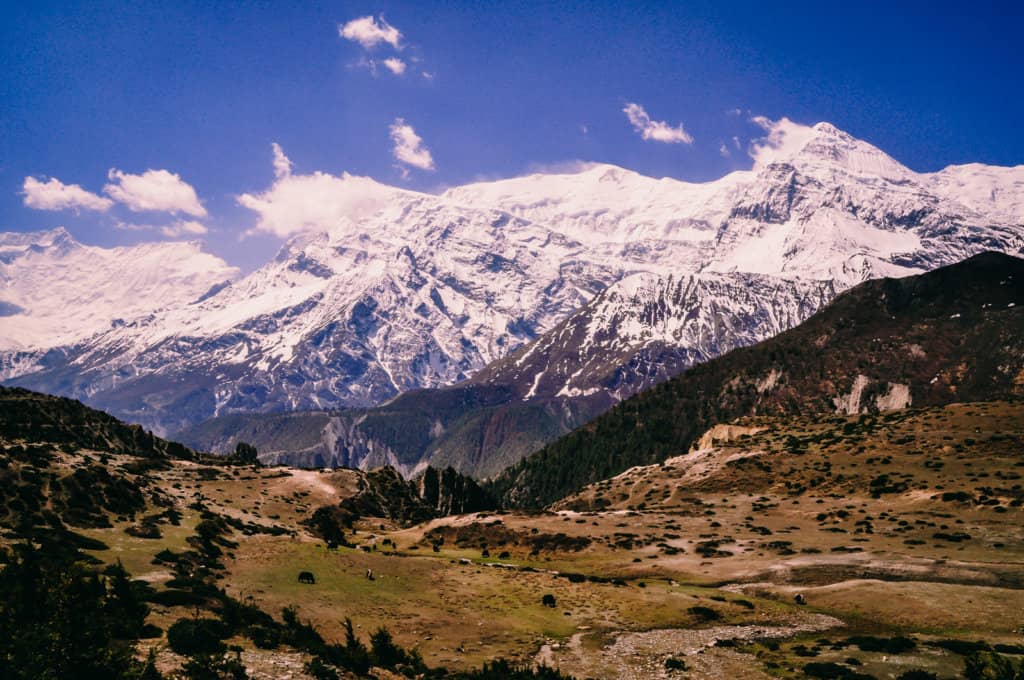
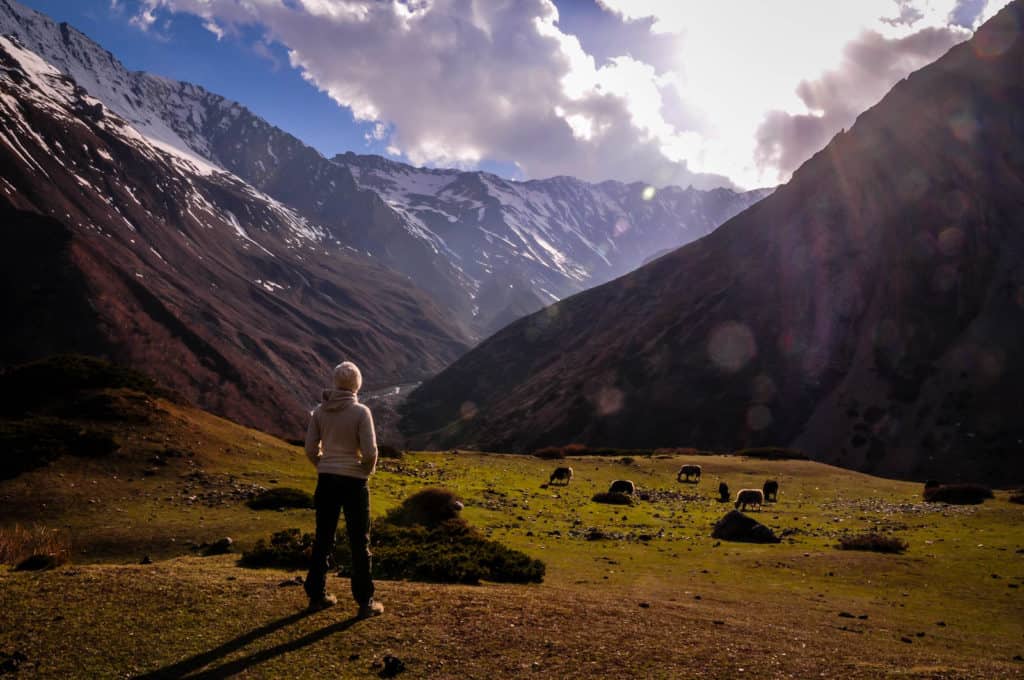
day 9
Yak Kharka to Thorung Pedi
The sun was out in all its glory, reflecting off the mountaintops that looked like they were frosted in thick cream cheese, but it failed to thaw the frozen ground, or abate the fierce gusts of wind that found gaps between my four layers of clothing. I drank an entire pot of milk tea before I was confident that my facial muscles were sufficiently defrosted to move on to chewing with my mouth closed.
We set off on a trail that eventually tapered into a narrow, gently climbing path, and in single file ascended 400m in elevation through rock, debris, and snowfields peppered with resilient, sturdy bushes. It was a rather bland landscape, with little to break the grey-white monotony. Even a herd of wild horses only added further shades of browns, blacks, and whites to the desaturated palette. At this altitude saving your energy is key, and every bout of over eagerness came back to bite me in the form of having to wheeze up the next steeper slope, panting for air.
I’m not a fan of heights, but especially not in combination with unstable landslides like the slippery scree avalanche across our path. Dawa didn’t help matters by telling me to cross the loose gravel and sand with speed while hugging the slope, and to please not slide into the bottomless abyss below. By mid-morning we arrived in Thorung Pedi at 4450m and while we wanted to continue to High Camp at 4925m, Dawa was meeting up with friends at the Thorong Base Camp Lodge, deterring us from moving on with reasons like “it’s impossible to sleep at 5000m” and “there’s no proper rooms at high camp”. While these were not entirely true, we stayed put.
This was not my favourite day on the trek. The entire place was tossed about by violent, piercing gusts of wind. Our room was draughty and filthy, with the most abominably reeking squatting toilet yet, attached to our room behind a door that wouldn’t close. The definition of cold acquired a new meaning for us, as it mercilessly laughed in the face of sleeping bags, cup upon cup of milk tea, lemon-ginger tea, black tea, think of somewhere warm-therapy (this is a friend’s approach, which I tried though I know it doesn’t work – I was that desperate).
The dining room had burnt down in a gas explosion a year ago and was temporarily replaced by a tent with a small electric heater. Numerous workers were earning their living by building new facilities through manual labour without the help of electronic tools or machinery. No one wore safety glasses as they chiselled large stone slabs into flagstones by hand.
track details.
Route: Yak Kharka (4050m) – Thorung Pedi (4450m)
Time: 2:15 hours (incl. small breaks)
Accommodation: Thorong Base Camp Lodge
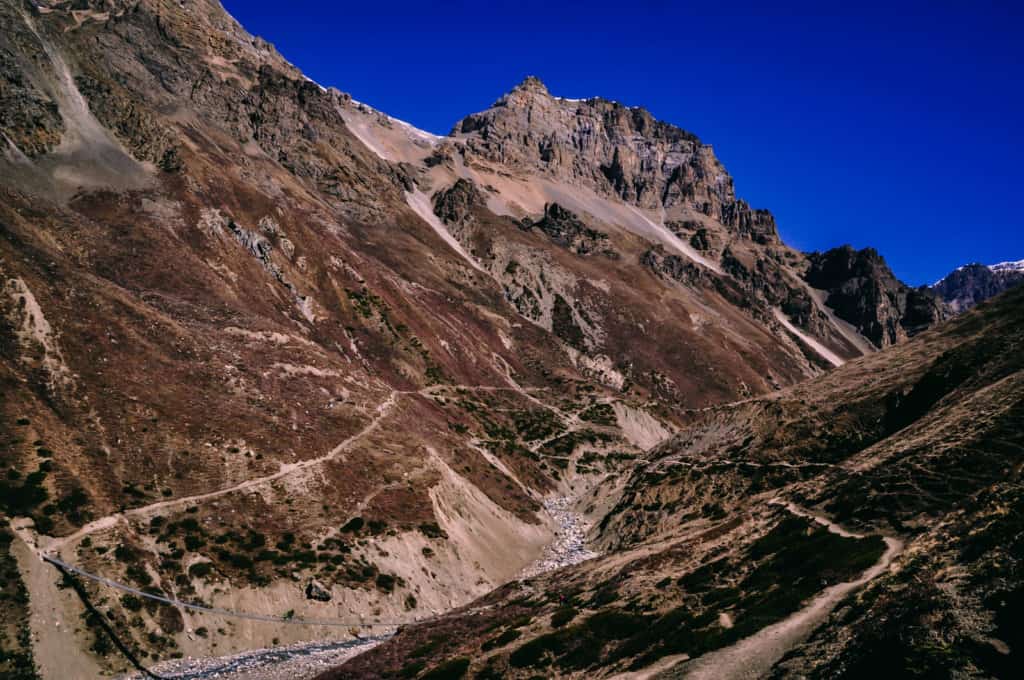
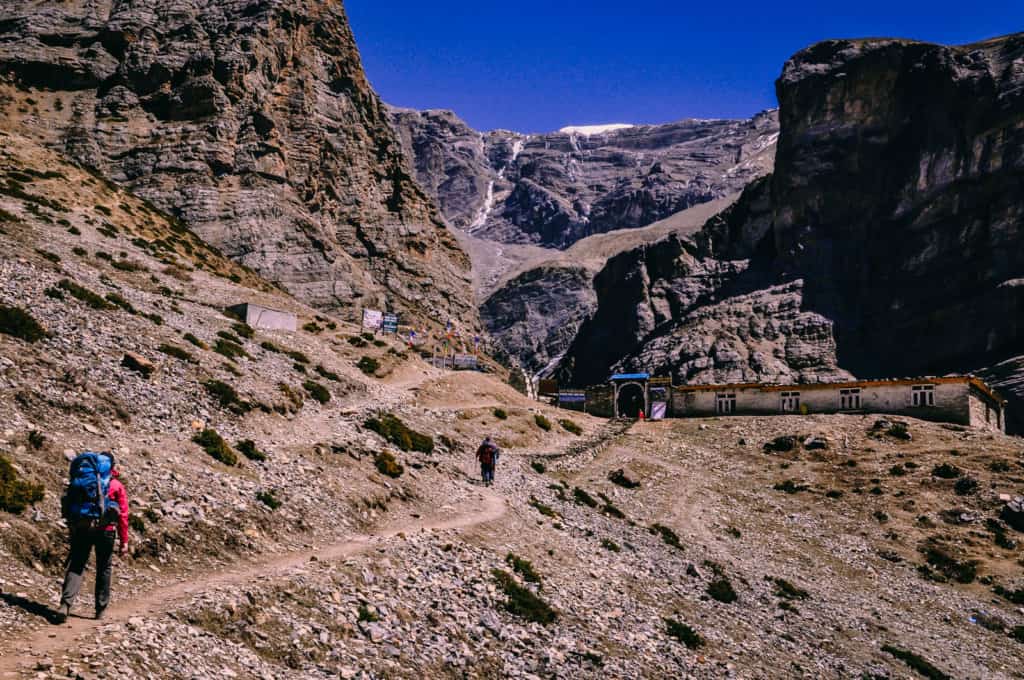
day 10
Thorung Pedi - Muktinath: Crossing the Thorong La Pass
At 3am four Israeli guys in the room next door started shouting. Still drowsy, I thought they were overly excited about the ascent to the path, or cold and doing some kind of contemporary dance to warm up that involved banging their fists and knees on the floor and wall.
But then, wide awake, I realised only three were shouting and cheering their mate who vomited but a meter or two from our door. I didn’t go back to sleep after that, partly because the noise didn’t stop with the vomiting, but also because I started to worry about the lack of feeling in my toes. I panicked slightly, remembering my Mum telling me about a friend who lost a toe to frostbite after wearing rather skimpy but stylish shoes to a St Martin’s day parade in early November in Germany.
When Dawa pounded on the door an hour later, I jumped out of my sleeping bag with eagerness, keen to get moving. We set off at 4:40 am. While I had expected the 1000m increase in altitude up a steep slope, and subsequent descent of 1700 metres to be challenging, I hadn’t bargained for the paralysing cold turning my feet, hands, and face into painful blocks of ice. When at long last the temperature climbed slightly higher and warm, soft sunlight painted the scenery in hues of orange and gold we reached High Camp.
The climb is doable, but exhausting to the point of having shaking, sore legs, and gasping for breath. Dawa was surprised by the number of snowfields we had to traverse. For years he had hiked the Annapurna Circuit several times a year, yet it was the first time he’d seen it snowed under. Weren’t we lucky! Who would have wanted to miss out on ankle-deep snow trickling into one’s boots, I thought, as we skidded across patches of icy packed snow.
Along the way we passed hikers who could barely manage to set one foot in front of the other, and by the time reached prayer flags streaming in the wind on the highest pass in the world, we had outpaced all but one of the 50 hikers that crossed the pass that day. The view was truly breathtakingly beautiful, and up here it was arrestingly quiet.
At half past eight Dawa led the way to Muktinath, descending on a serpentine trail down scree slopes and across snowfields as their surface thawed slightly in the sun and turned from treacherously icy to sludgy. The rugged gravel wasteland was gradually dotted with more green fields that from afar resembled brush strokes and looked incredibly vivid and welcoming in this grey desert.
We clambered downhill for hours on wobbly knees and sore thighs and at 12:40 reached the Hindu pilgrimage town at 3760m. The Hotel Northpole, was a wonderful place with hot showers (and I mean truly hot showers) for 100Npr, and a rooftop terrace to have lunch on in the sun afterwards. Isn’t it marvellous that thanks to the mysterious workings of the human mind positive experiences most often trump negative ones? A power outage plunged diners in the whole of Muktinath into complete darkness, but after a two-hour power nap, talking Dawa into sleeping in the following day, and dining by candlelight, I thought that crossing the Thorong La Pass had been nothing but wonderful.
track details.
Route: Thorung Pedi (4450m) – Muktinath (3760m) across the Thorong La Pass (5416m)
Time: 8 hours (incl. 50min break)
Accommodation: Hotel Northpole
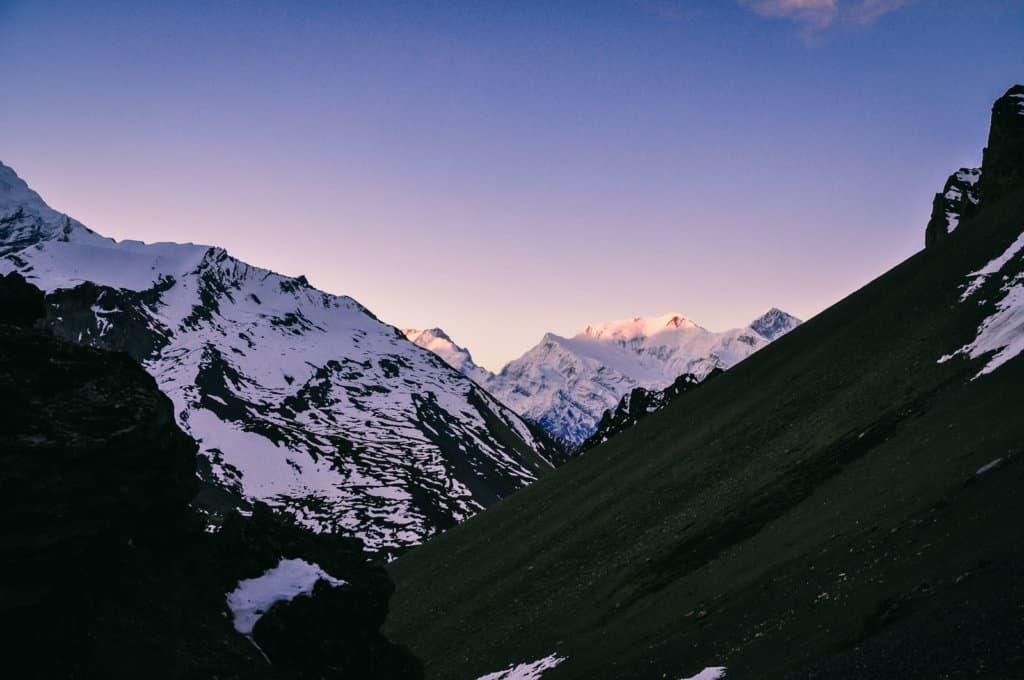
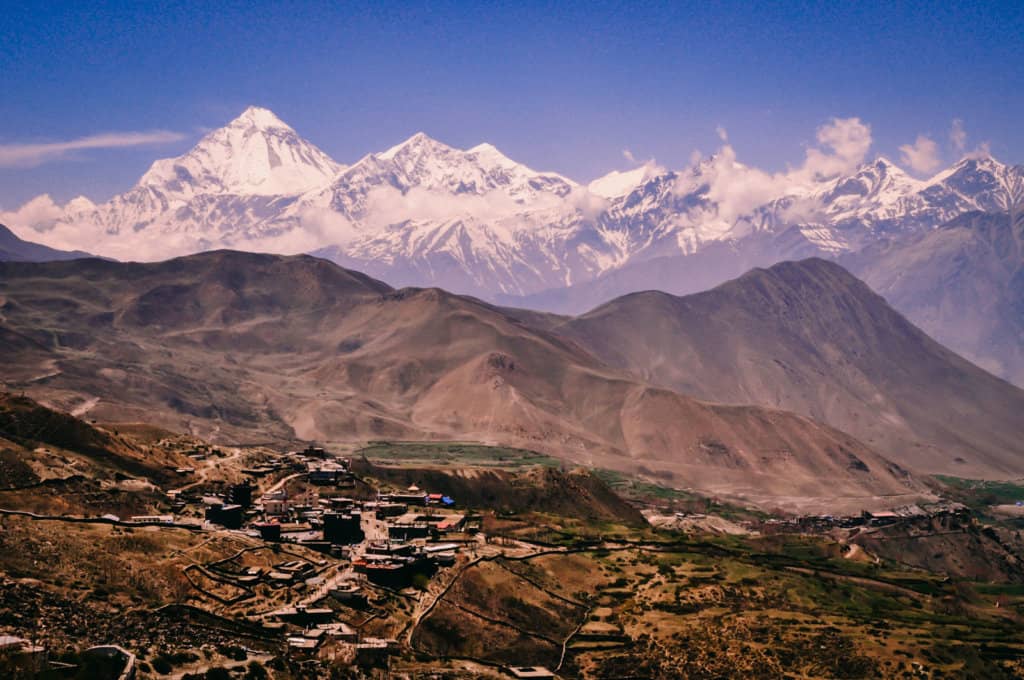
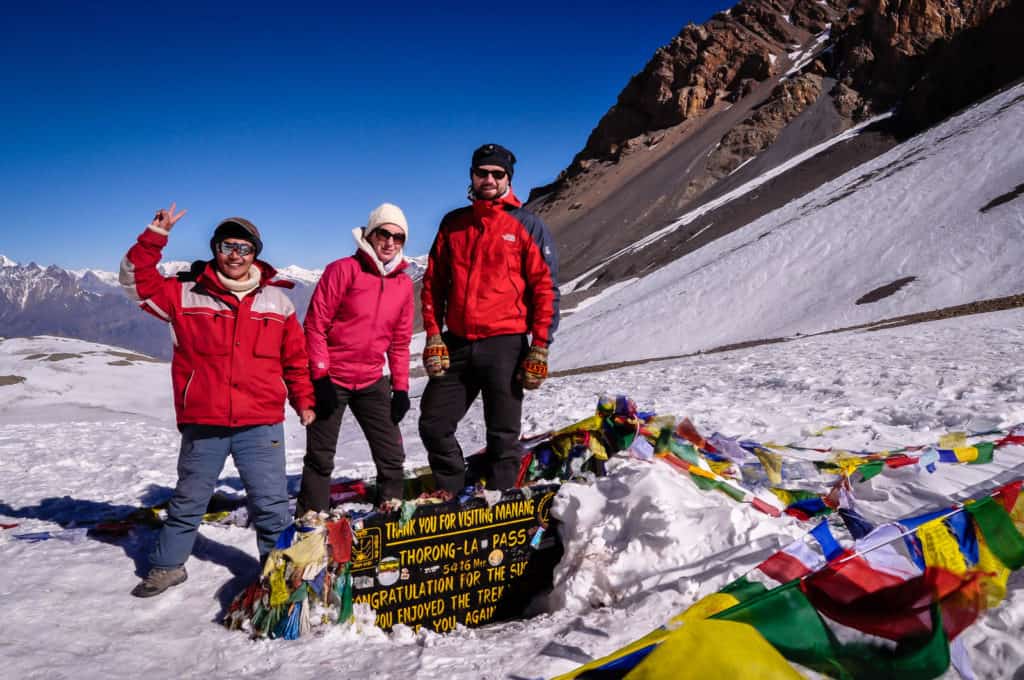
day 11
Muktinath - Jomoson
The leg to Jharkot led through pastoral mountain hamlets and beautiful lush green terraced fields. Newborn calves stalked about on wobbly legs, but baby animals were not the only bounty of spring. All around us trees put forth new shoots and shiny green buds, momentarily transforming into light green curly leaves, and tiny, sweetly scented blossoms. They harmonized well with the snow-capped mountain backdrop, conveying a sense of purity and reawakening.
If I ever questioned having muscles in my thighs and calves I was well reassured of their existence as they were dreadfully sore today. Muscle pain always reminds me of ballet classes as a child and of our ballet teacher, who was nice but also rather pitiless. The motto she followed – the only cure for pain is more pain (meaning exercise) – was rigorously applied to complaints about sore muscles and evidently also her own issue. She mixed schnapps with coffee in equal measures and had two such coffee concoctions during a 45min session. By the time I graduated to the most advanced level, mine was the fourth class she taught on Tuesday afternoons and it was time to quit.
After a tea break in Ekle Bhatti at 2740m we walked on a level path across an arid, dusty scree plain devoid of any vegetation for more than an hour. There was little alteration in the monotony of this desert of stone, except for powerful gusts hurtling across the plain, spinning us every which way, and the SUVs, busses, and motorbikes jolting past us engulfed in ochre-coloured dust clouds. The dust settled in our noses, mouth, and throat, and plagued by raspy coughs and thunderous sneezes we were happy to arrive in Jomosom.
The village was surprisingly large and we walked through it for a good twenty minutes, including a stop at the local police station to get our trekking permit stamped, to the Hotel Mustang Monalisha. For the first time on the Annapurna Circuit we had a proper ensuite room. Imagine my joy at discovering hot water flowing from the showerhead, and – this was absolute bliss – a Western style flush toilet. One would be hard pressed to find an uglier train station toilet in Germany, which are the most awful public toilets in my experience, but to me, today, our ensuite room was luxury.
There was one downside to the room. Certainly, with the best intentions someone had carpeted it, yet it looked like a vacuum cleaner was yet to be introduced. We had lunch, showered, read, had more tea, discovered one English speaking channel – Al Jazeera – on the mini TV in our room, stopped watching Al Jazeera because our sight was too bad for analogue TV on a 32-inch screen across the room, and had more food. Jomosom itself was noisy, hectic, and dusty but offered more comfort to hikers passing through or boarding one of the daily flights to Pokhara than the smaller villages along the trek.
track details.
Route: Muktinath (3760m) – Jomoson (2720m)
Time: 5 hours (incl. 30min break)
Accommodation: Hotel Mustang Monalisha (this is not a typo)
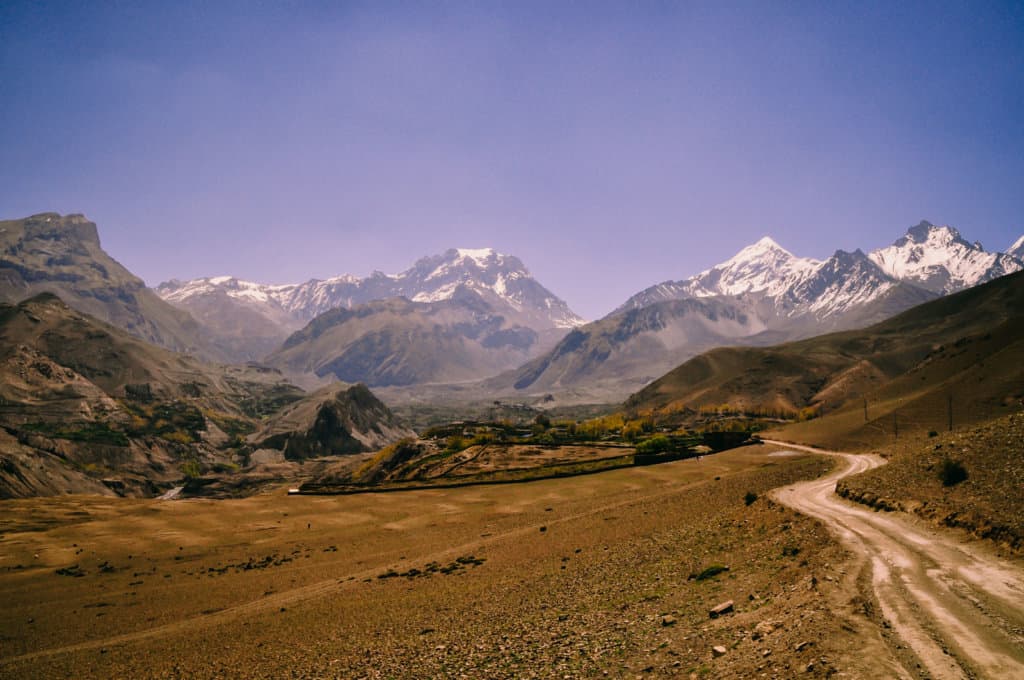
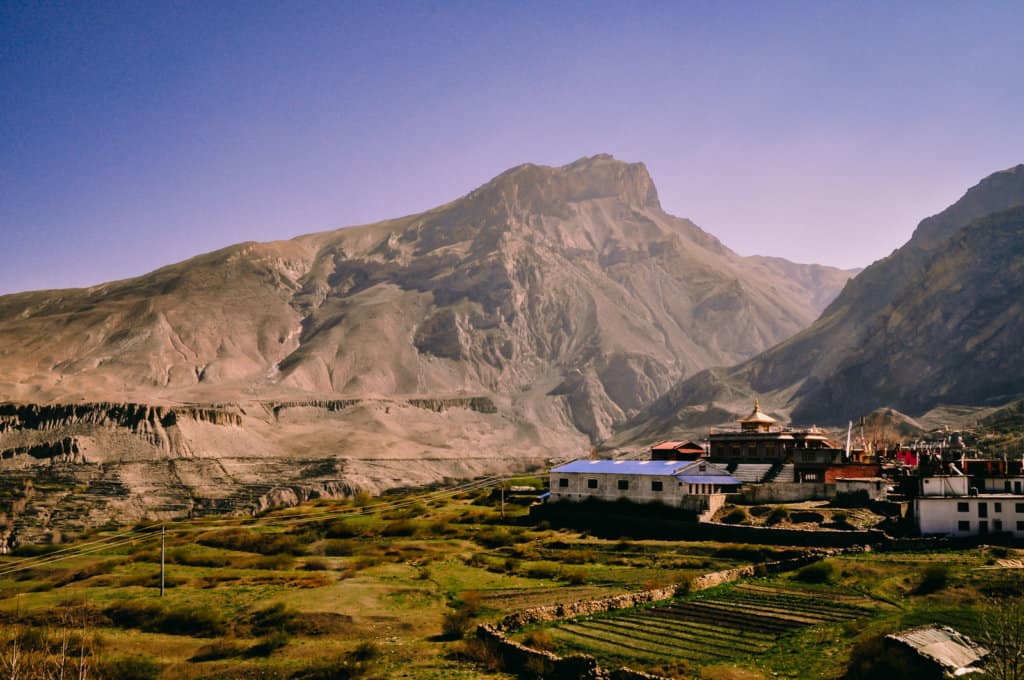
day 12
Jomoson - Tatopani
If we regret one thing on the Annapurna Circuit it’s taking the bus from Jomoson to Tatopani. Harka, the tour manager and Dawa had both warned us that it was a bad idea to hike along the heavily trafficked and dusty road. Yet getting up at 5:30am to catch a 7:00am bus, that didn’t move off until after 8:00 put me in a rather pissy mood, as I realised I could have slept in. What didn’t help matters was the tiny size of the seats. It was a local bus built for locals, of whom I had not seen anyone taller than 1.70m.
While I managed to squeeze into a window seat, banging my head on the overhead locker, Tobi, who is 1.84m sat sideways next to me, stretching is legs into the aisle as the row in front of him started halfway up his thigh. The suspensions were also not the greatest, and a real risk for anyone with spinal disc issues. The views themselves were spectacular yet oftentimes marred by the hair-raising habit of the driver to lean the bus almost vertically into a sharp curve, resulting in passenger staring into a gaping abyss, merely two handbreadths of loose gravel between tyre and ledge. I groaned when on the four-hour drive we passed ten vehicles at most.
They did indeed whirl up gigantic dust clouds, like Harka and Dawa had warned us, but we sat in one of those bloody plumes of smog for the entire ride. Luckily, we had wrapped our backpacks, which were transported on the roof, in plastic bags for my beige fleece had dyed a light chestnut colour from the powdery dust thirty minutes into the drive. And lastly, there was music on full blast the entire time. Bollywood music to be precise (I’m no fan is an understatement), blaring from a loudspeaker right above my head at a volume one may find at a club.
When we stumbled off the bus more exhausted than after crossing the Thorong La Pass we were in dire need of a shower. It was in that shower, in a room on the ground floor, that a giant specimen of the one species of insect that Tobi hates even more than me waited for us – a cockroach. Petrified with horror we retreated straight back out the door and demanded an up-grade, as in higher up. I wanted to be higher up as my theory was that if I were a cockroach I wouldn’t see the point in climbing a vertical wall to start somebody screaming if I could just as well do that downstairs, yet unfortunately there was only one floor.
track details.
Route: Jomoson (2720m) – Tatopani (1190m)
Bus Ride: 3:45 hours (ticket/person 1200Npr)
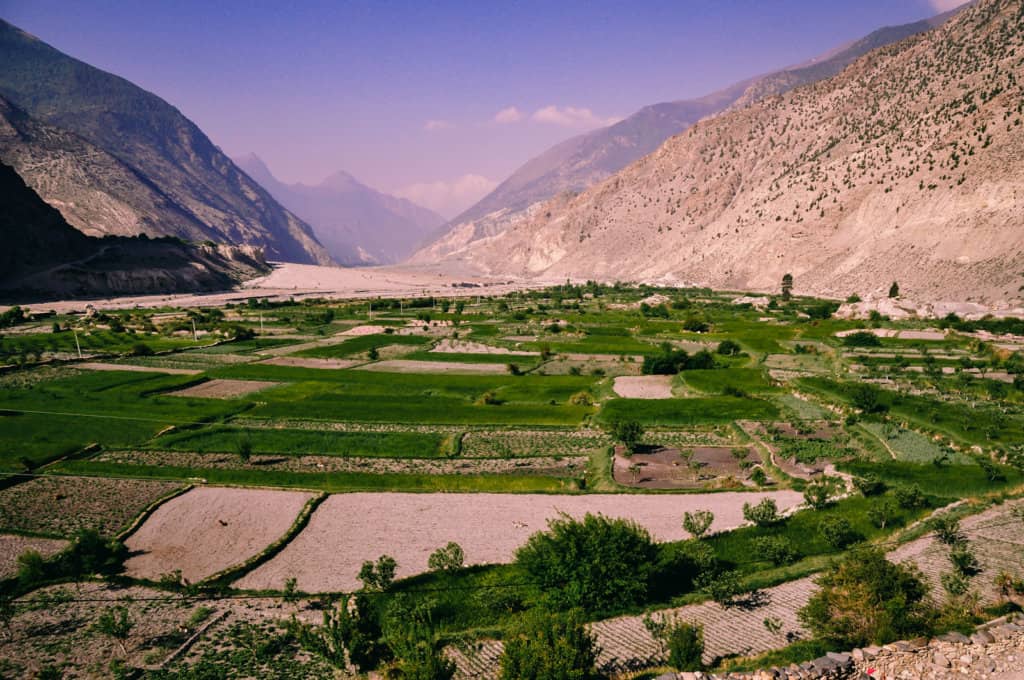
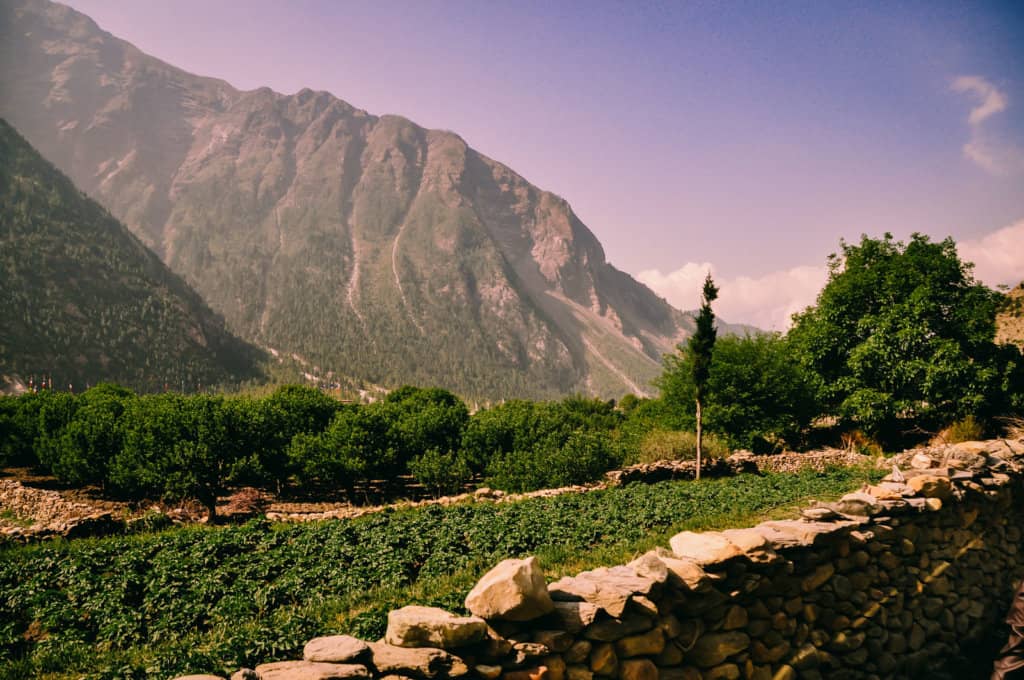
day 13
Tatopani - Ghorepani
We woke to sunshine, somewhat dimmed by a thick layer of fine dust, and started the day, which would turn out to be the second most physically challenging on the Annapurna Circuit, with banana pancakes on the veranda. I had really missed bananas at higher altitudes, but now they were back in nearly every dish on the breakfast menu, and the courtyard outside looked tropical with heavily laden banana trees flanked by two orange trees.
Just out of Tatopani we crossed the Kali Gandaki River on a rickety swinging rope bridge and climbed up cumbersome stone steps for the rest of the day. I have short legs and those steps were made for giants. After several hours of climbing uphill my knees were shaking badly but as a reward we felt deeply immersed in this marvellous, lush countryside, and closer to local life than ever before.
Dawa confirmed that agriculture is the most important source of income in this region and we could only guess as to how difficult the cultivation of corn, potatoes, beans, tomatoes, and grain on the rugged, inaccessible slopes to our left and right was. Men and women stood on terraced fields cutting corn stalks with sickles. The ears were carried to the villages in large baskets on their backs and then threshed with sticks to sift chaff and straw from the wheat. Not even old age allowed for a rest from manual labour. A wiry, elderly farmer, his skin weather-beaten and wizened, stumbled after an old wooden plough drawn by two stubborn oxen and swore vilely (one didn’t need to speak the language to understand that) as he dressed the fields for sowing.
I would likely never feel as accomplished about making my own home-baked bread ever again, not after seeing these people manually producing the ingredients for bread themselves. My definition of (running to the store and buying all the ingredients and) baking bread would no doubt elicit no more than a weary smile from these hard-working farmers. A dozen baby goats ran after us and seemed terribly excited when the most courageous two dared licking my calf with their tiny, tickling tongues. They appeared to like sweat, suntan lotion, or dirt, all of which was overabundant on my skin.
They seemed completely unfazed by human company, as were the heavily laden mules trotting past and effortlessly clambering up the steepest inclines. The colourful, vain roosters that strutted past uncomfortably close, reaching above my knee, were less happy with our proximity, and keen to defend their territory. I wished they’d instead feed on the horde of annoying and disgusting shiny green flies that followed us all day in a halo above our heads. At least perpetually flailing my arms to fend them off as we struggled up more steps ensured a well-balanced workout for the day.
We passed by Ghara at 1700m and stopped for lunch in Shikha at 1935m on the rooftop terrace of a guesthouse with panoramic views of the valley. Just below primary school kids played volleyball during their lunch break. The boys wore ties and the blue and white uniforms of the girls reminded me of my own college colours. While a few days ago my biggest worry was the freezing cold and frostbitten toes, I was now drenched in sweat and craving a shower. Hiking was most certainly living up to its promise of variety.
On the last stretch of steps, up a particularly relentless ascent to Ghorepani, the sky dimmed to a dirty, featureless grey, and by the time we sat down in a café over coffee and cake to wait for Dawa, sinister clouds gathered on the hillsides with alarming swiftness. When he finally showed up, and we made a run for it, it was too late. On the five-minute run to the Nice View Hotel, the clouds burst open and discharged a furious hailstorm. Hailstones the size of cherries pelted down on us with furious might and within minutes the clay soil was thickly coated with white pellets.
The guesthouse was fairly new, which was lucky, as someone had again thought carpet without a carpet cleaner was a smart idea. Dawa mentioned the option of hiking to Poon Hill at 3193m very early the next morning for amazing views of the Annapurna mountain range. Although, he added, we would reach an almost identical viewpoint on tomorrow’s leg between Ghorepani and Ban Thanti. We decided against getting up at 4:30am.
track details.
Route: Tatopani (1190m) – Ghorepani (2860m)
Time: 7:30 hours (incl. 1 hour break)
Accommodation: Nice View Lodge
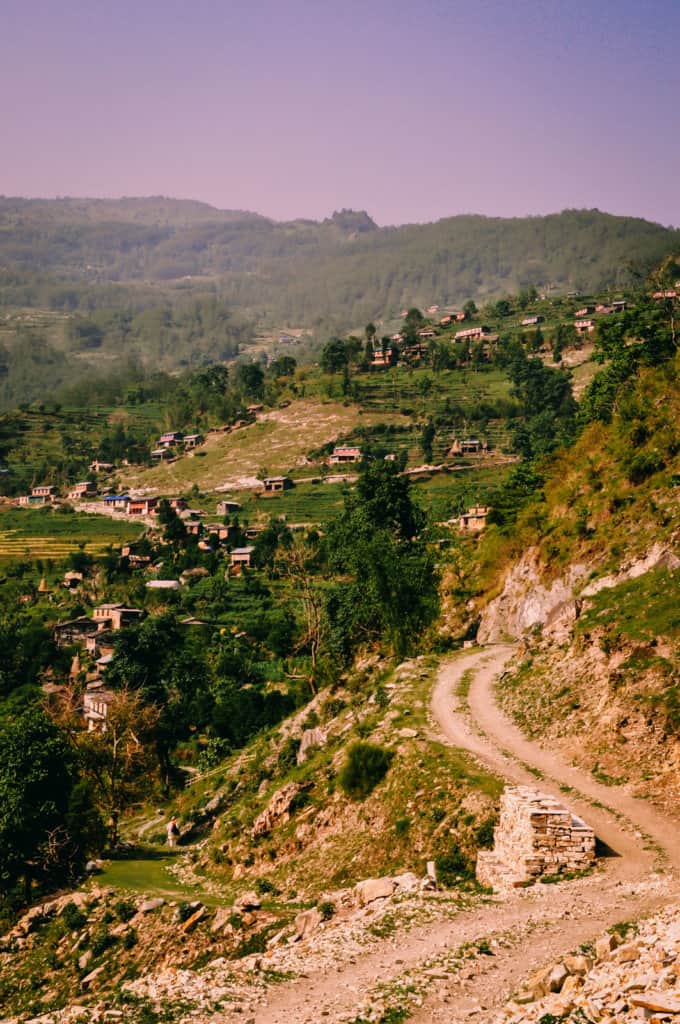
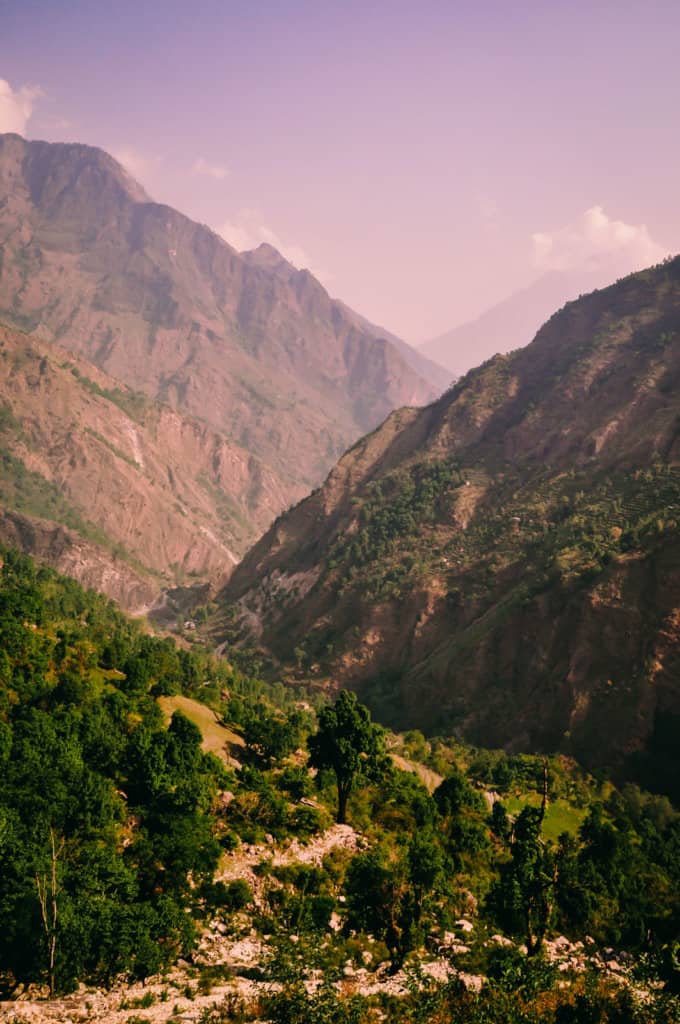
day 14
Ghorepani - Ghandruk
We bid farewell to the pretty village of Ghorepani with its cheerful blue roofs, passed by the school’s sports field and basketball hoop, and picked up where we left off the day before – climbing steps, steadily up and down, for the next six hours. They were slippery from yesterday’s rain, full of soaked moss and lichens, and covered in a slimy sludge of grime. Though I’d complained about climbing up steps, climbing down was actually worse, and my knees didn’t thank me. Yet the scenery is some of the most marvellous on the entire Annapurna Circuit.
Without a break we hiked steeply up to 3000m through woodlands and pastures and caught our breath when we reached the viewpoint that Dawa mentioned the day before. He hadn’t exaggerated. The snow-covered mountain backdrop was spectacular even when shrouded slightly in morning mist.
The next part led through a large rhododendron forest, which resembled a magical storybook enchanted forest in paradise. The trees raised a dark green canopy closely dotted with blazing pink blossoms, and yesterday’s rain had washed thousands of these beautiful blooms onto the ground, leaving a reddish pink sea for us to wade through, which Dawa fittingly called a ‘designer carpet’ . But just as I struggle to capture the carpet’s beauty in words, I believe a designer could not recreate such a pristine and perfect piece of art.
In Tadapani at 2630m we stopped for a well-deserved lunch of thick banana pancakes at the Super View Teahouse and started off again on a three-hour walk through rain forest. Old trees reached across the trail with gnarled roots, heavily overgrown with spongy moss. Quite often these slippery, knobbly arms had slashed their way through the soil to appear at the surface, breaking through the stone slabs that were meant to stop us stumbling through the underbrush. Vines dangled from the treetops as if waiting for Tarzan, and small spiders bolted away terrified, as the shadow of our boots descended upon them. Whistling birds followed us instead of devouring the ladybugs that crawled up small branches with angelic patience.
The smell was different to any we had experienced in Southeast Asia in the preceding months: it was a slightly mouldy, rotten, and very intensely wooden smell. As we neared the next village the excited buzz of a bee colony competed with the gurgling sound of the crystal-clear creek we followed downstream into the valley. We crossed several ramshackle wooden bridges and entered Ghandruk. While Ghandruk had no discernible village centre, its approximately thirty hotels were spread along the slope, interconnected by stone stairs, all boasting the same fantastic view of the valley.
track details.
Route: Ghorepani (2860m) – Ghandruk (1940m)
Time: 7 hours (incl. 45min break)
Accommodation: Hotel Manisha
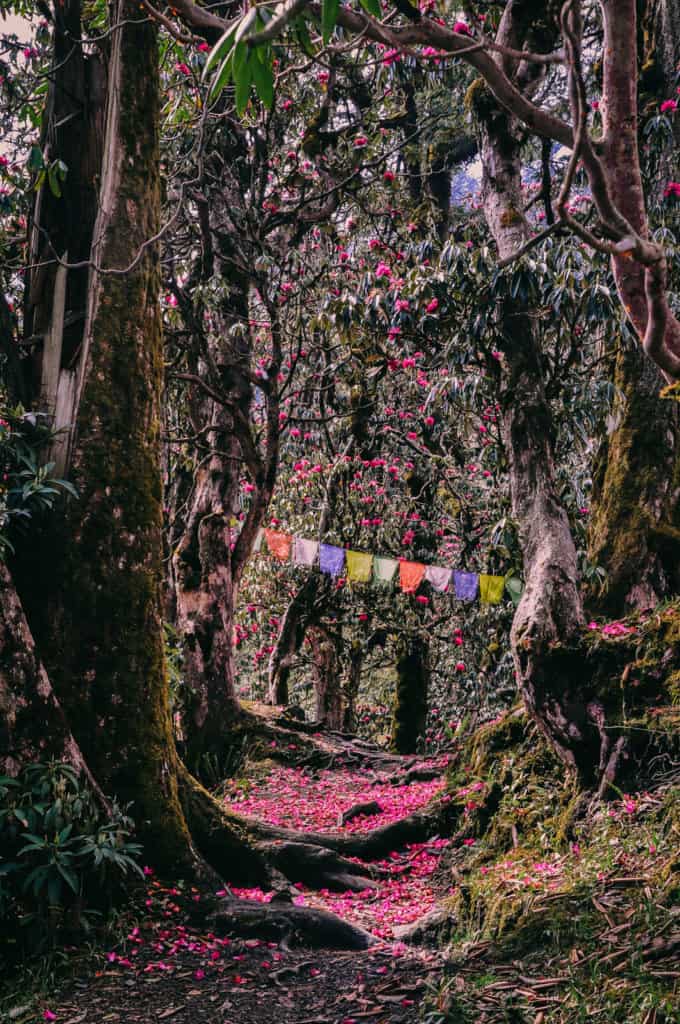
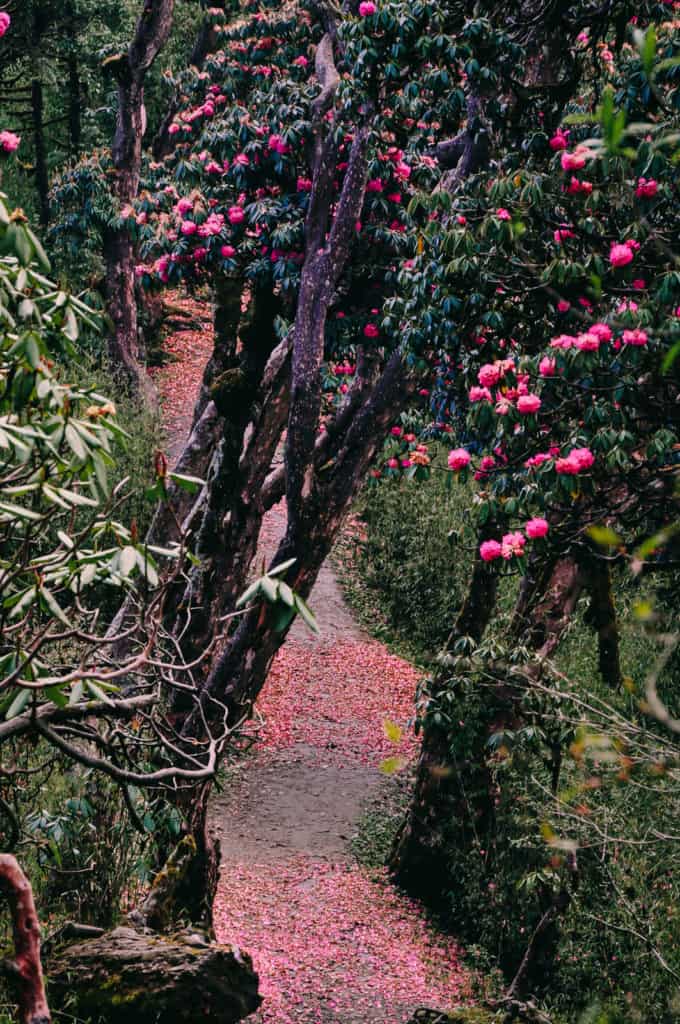
day 15
Ghandruk - Pothana
Before starting on our last full day hike on the extended Annapurna Circuit, we discussed two possible routes for today’s leg – an exhausting ordeal struggling in the direction of Dhampus to Pothana, favoured by Tobi, or a comfortable, shorter hike towards Birethanti, preferred by me and my weary legs. I lost the argument and was too knackered to jump for joy at the sight of more never-ending steps leading down 600 vertical metres to Ghandruk. Here we crossed the Kyumi river on a shaky wooden bridge. On second thought, I take shaky back – my wobbly legs possibly conveyed that impression.
The river wound its way through the valley in between terraced fields on steep slopes cloaked in green, and marked the point in today’s leg where we switched up stumbling down steps with stumbling up them. The climb to Landruk at 1565m dragged on but the pretty mountain village was well worth the effort. Most Nepali we’ve met spoke a little English, enough to make themselves understood, but not so the lean elderly man, driving cattle past us today.
It was the first time someone enthusiastically and happily chatted with us without speaking a word of English. I think he commended us on clambering up the steep hillside (which he probably did a dozen times daily himself), at least I interpreted the thumbs up gesture and his amiable toothless smile as such. He laughed then apologetically made signs with his mud-caked hands to let us know he shovelled dung not so long ago, before gently touching our hand and his forehead. We read this gesture to mean hello and followed suit, which appeared the right thing to do.
During our lunch break in Tolka dark rain clouds approached across the mountain crests from all sides and thin greyish rain streaks already streamed into the valley between Ghorepani and Landruk. Soon after the first drops fell into the mud next to us. Pouring rain and endless steps were not a happy combination, particularly on stones covered in treacherously slick moss. My legs were utterly exhausted, and I considered whether simply sliding down the next muddy slope on my butt would be a better option to reach Pothana.
track details.
Route: Ghandruk (1940m) – Pothana (1890m)
Time: 6:15 hours (incl. 45min break)
Accommodation: See You Lodge
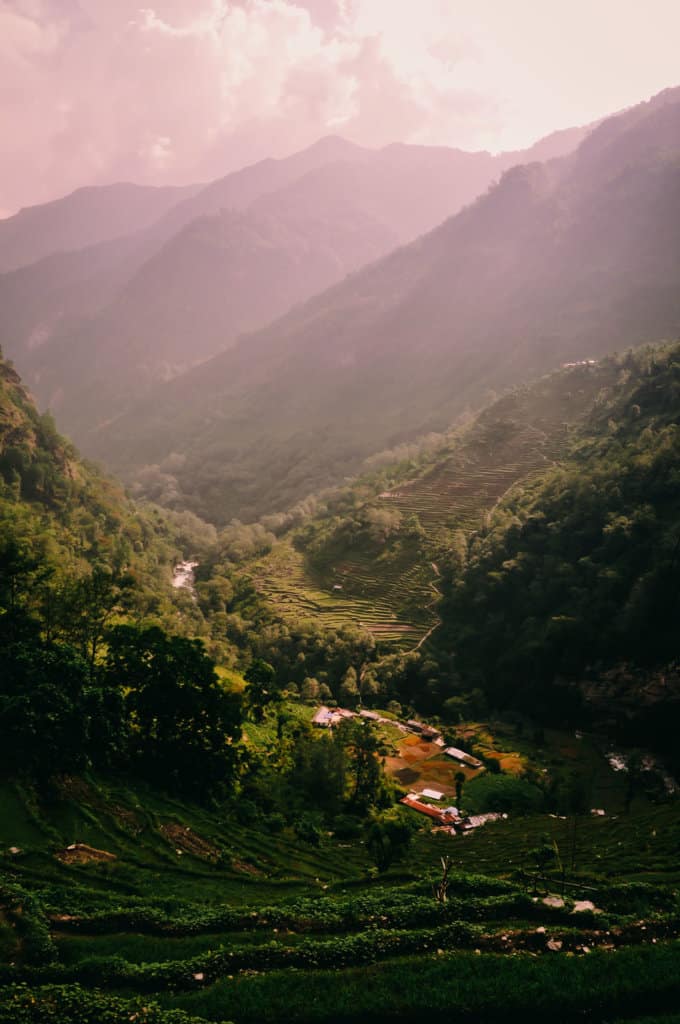
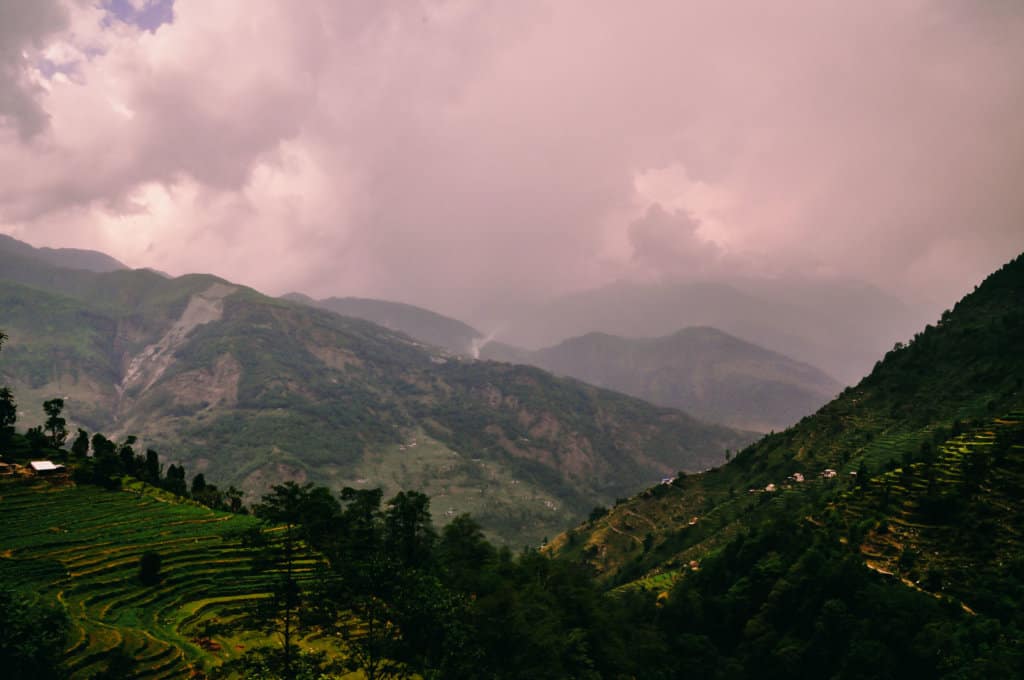
day 16
Pothana - Pokhara
We got up at 5:45 am though the last stretch from Pothana to Phedi would only take us three hours at a slow pace. But our clothes, and I mean all of our clothes, were in dire need of a rendezvous with a washing machine in Pokhara that afternoon. The breakfast that morning became embedded in my memory more than any other on the Annapurna circuit. It wasn’t just the delicious banana pancakes and milk tea, but also sitting in a pretty garden after a chilly night, surrounded by blazing flowerbeds in the warming sunshine on a beautiful day in spring, I didn’t tire of looking at undulating dark green valleys and the snow-covered Fishtail Mountain looming on the horizon.
The descent also seemed less steep today, though that may have been partly due to the prospect of a clean hotel room, Western style bathroom, and snug bed. We took today’s leg in our stride despite our sore legs, and the obstinate water buffaloes trotting along the dirt road, parking their big butts and curved horns right in the middle. After a good two hours, followed by the merry calls of cuckoos we reached the tarred main road to Pokhara. Dawa organised a taxi/friend to take us into town.
The vehicle consisted of sheet metal barely held together by duct tape, and I was surprised when it didn’t disintegrate on driving 60kmh in a 20kmh zone. Luckily it didn’t rain as the car’s windows were wound down, and there was no way to wind them up. Clearly vehicle inspections are overrated, as this car had never seen a mechanic in its life, and yet dropped us off at the hotel in one piece.
Pokhara stood in stark contrast to Kathmandu. It’s a smaller, tidier place, that lacks the chaotic traffic and thus the layer of exhaust fumes and dust which penetrated our facemasks in Kathmandu. I was just about to comment on how clean this town seemed when I froze mid-step. Just ahead stood several rubbish bins clearly marked with signs encouraging waste segregation. It’s been months of traveling through Southeast Asia and this was the first attempt I have witnessed to ease the environmental burden through recycling.
The main road was comprised of souvenir shops, cafes, and restaurants, and only a stone’s throw from Phewa lake, the main tourist attraction in Pokhara thanks to its famous mountain backdrop, though this was only vaguely discernible through the high cloud cover that hung around all day. For us this didn’t matter. The Annapurna Circuit, Ghorepani trek, and Ghandruk trek had spoiled us rotten when it came to vistas, and we will forever treasure this hike as one of the most beautiful and rewarding travel experiences.
track details.
Route: Pothana (1890m) – Phedi (1130m) – Pokhara
Time: 2:15 hours
Accommodation: Mountain House Pokhara
